Sourdough is the most popular bread right now, and just because we’re gluten free doesn’t mean we’re left out of the fun! Isn’t it lovely to know that you, too, can bake a lovely gluten free sourdough in nearly any kind of pan, any time you like?
Different Methods for Baking Gluten Free Sourdough Breads
Here are a few ways you can bake out my recipe for gluten free sourdough bread. One recipe, you choose your method!
Gluten free sourdough baked in a 6 quart Dutch Oven.
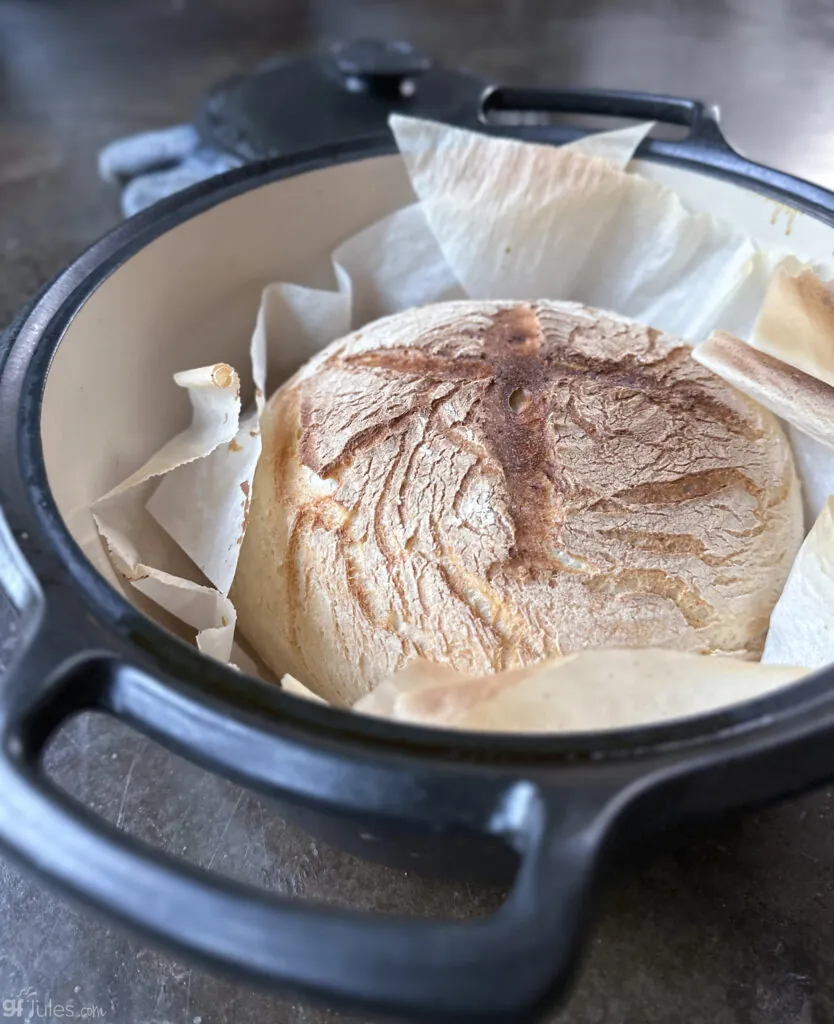
Gluten free sourdough made in an Emile Henry bread baker …
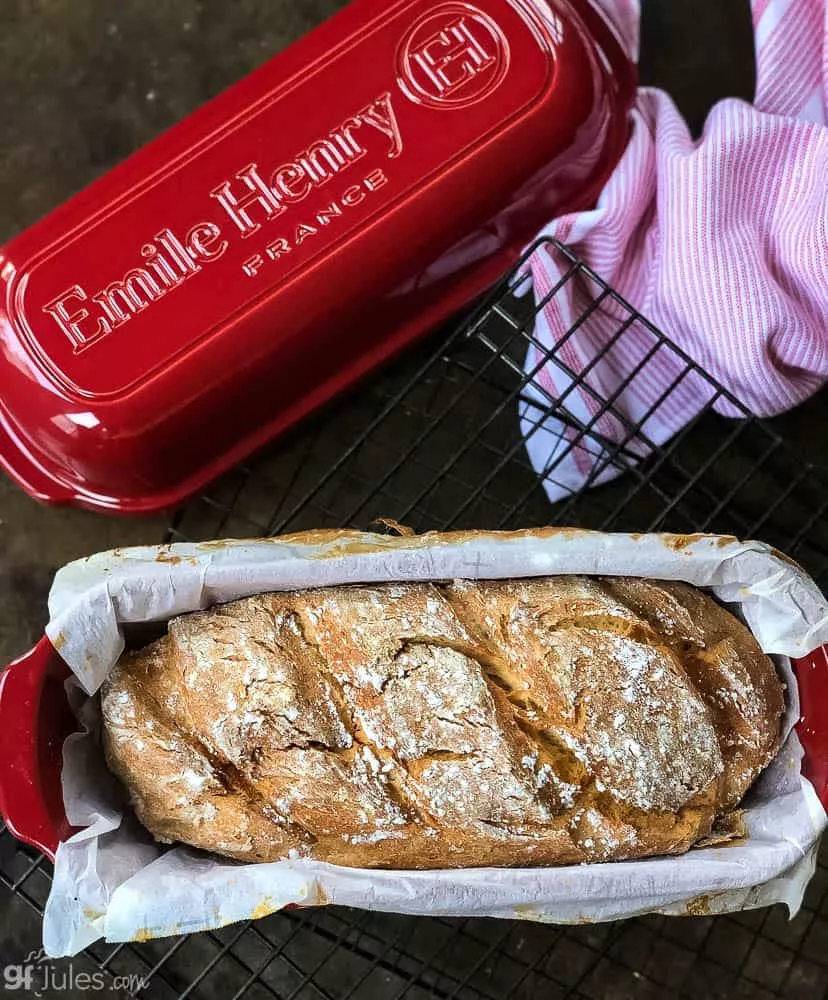
Gluten free sourdough baked in a Pullman Pan …
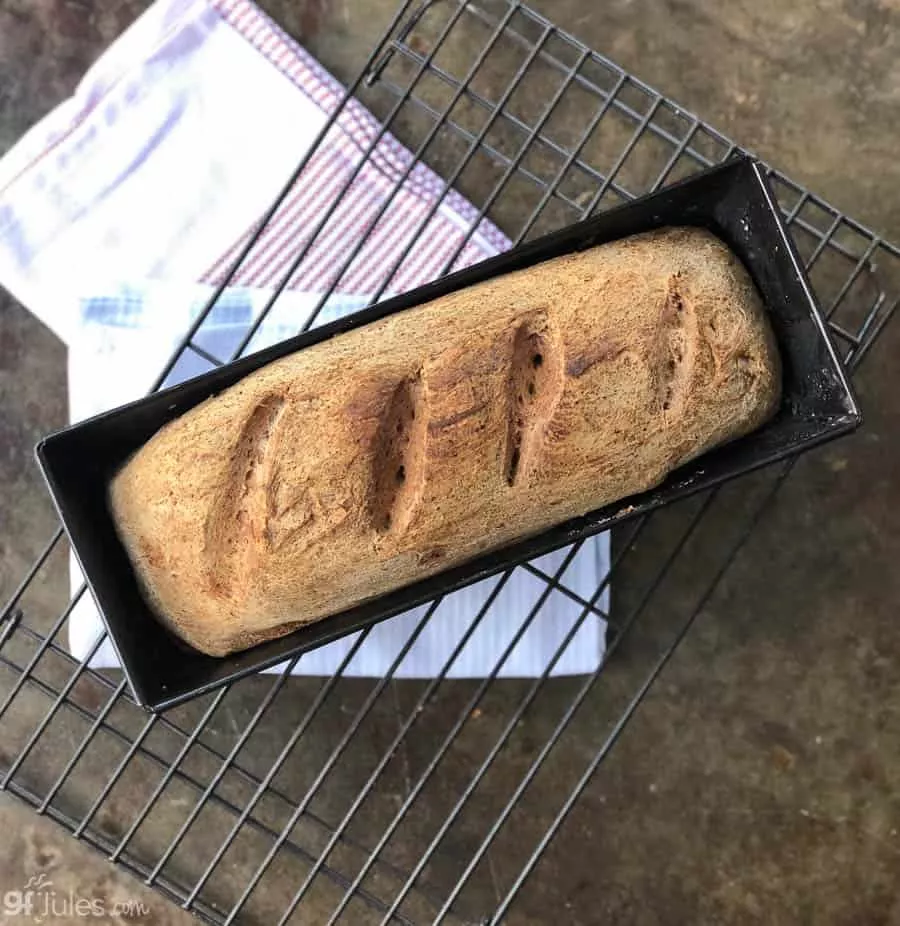
Gluten free sourdough baked as a boule without a pan …
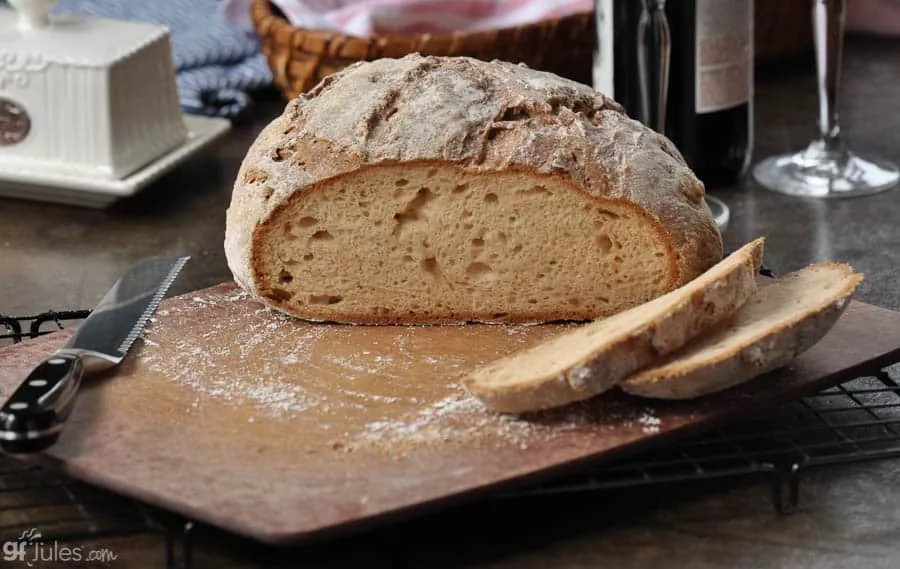
Gluten free sourdough baked on a baking steel and ultralight baking shell from Brod & Taylor. I’m loving this new-to-me method, by the way.
It’s similar to baking with a Dutch Oven, but the baking shell is so easy to handle and only weighs 1 pound 1 ounce! Comes in batard shape (shown here) or boule.
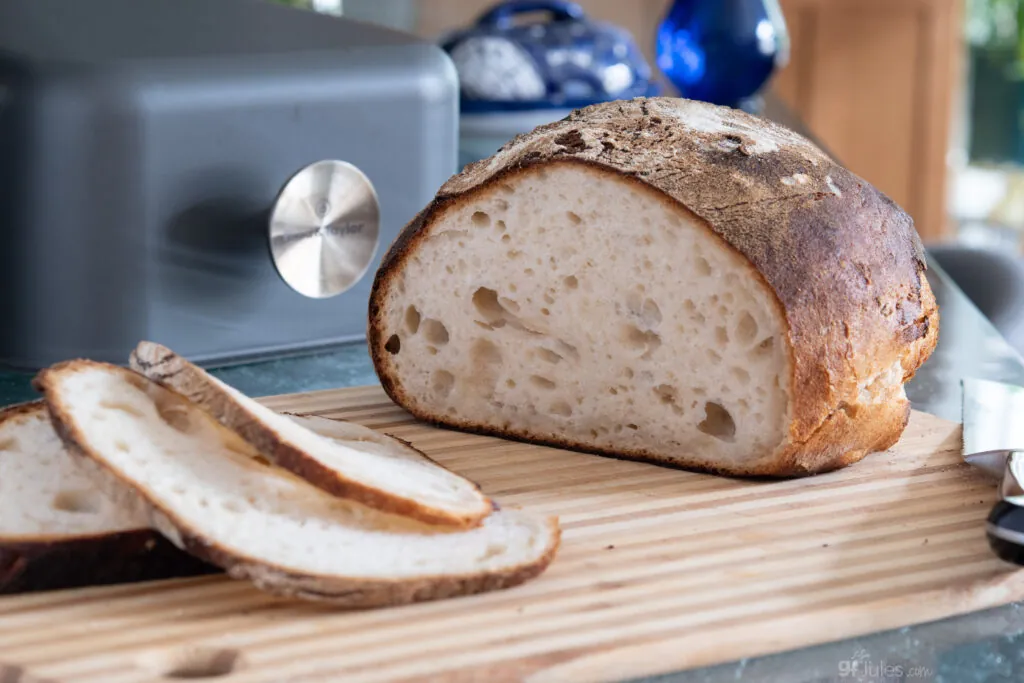
I’ve baked experiment after experiment, tweaking it here and there to account for lots of variables over the years, and I’m happy to share all my gluten free sourdough secrets and methods with you in this comprehensive post!
The creation of the first successful gluten free sourdough starter (click here for recipe) and gluten free sourdough bread recipe was a painstaking process, but at least we’ve enjoyed tons of gluten free sourdough along the way (leftover sourdough makes an insane overnight gluten free French Toast Casserole!).
I urge you to hang in there and read through my entire post, as I outline what has worked best and what has not worked best for me.
There are definitely some tricks of the trade, including how to get your gluten free sourdough to be sour!
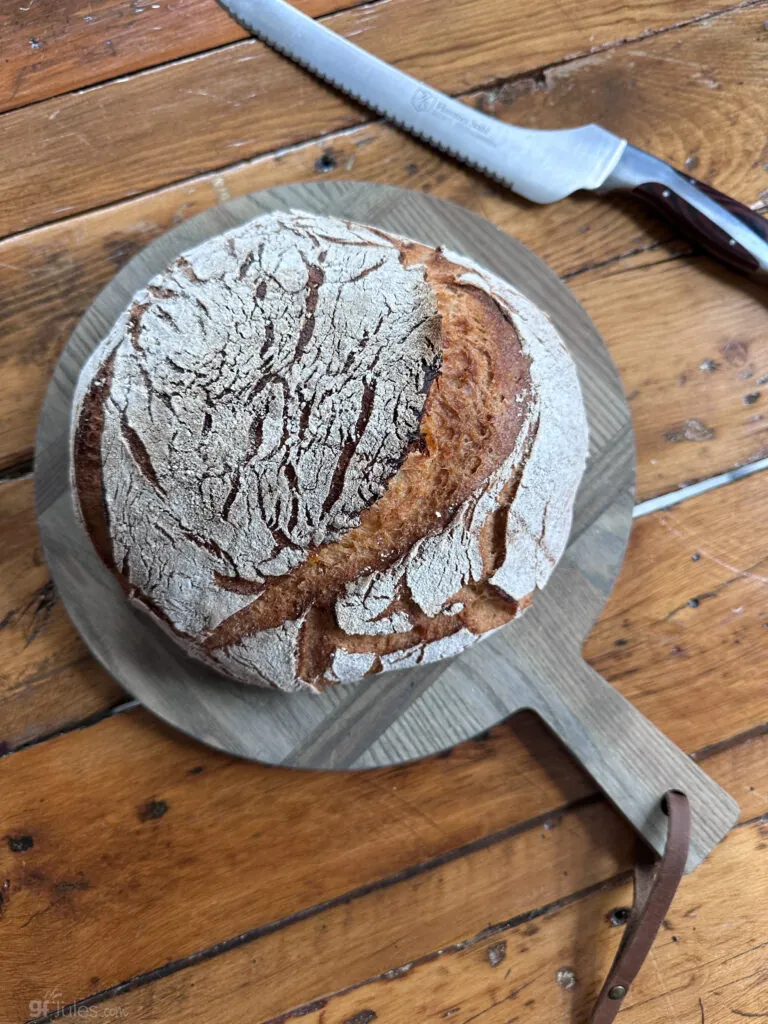
Gluten Free Sourdough Basics
For those who love and miss sourdough, take heart! The art of making sourdough isn’t lost without the gluten. There’s still a lot of feeding, caring and waiting for the sourdough starter to mature and bloom into all its potential.
I’ve actually made so much starter that I’ve given much of it away to neighbors, but I just couldn’t throw any away when I’ve tended to it for so long! It’s like a little sourdough baby and you just can’t toss it out — I care about it! It’s “alive.”
Pro Tip: Use the search bar here at gfJules.com and search “sourdough” for lots of delicious gluten-free sourdough discard recipes so you don’t have to waste any of your precious discard either!
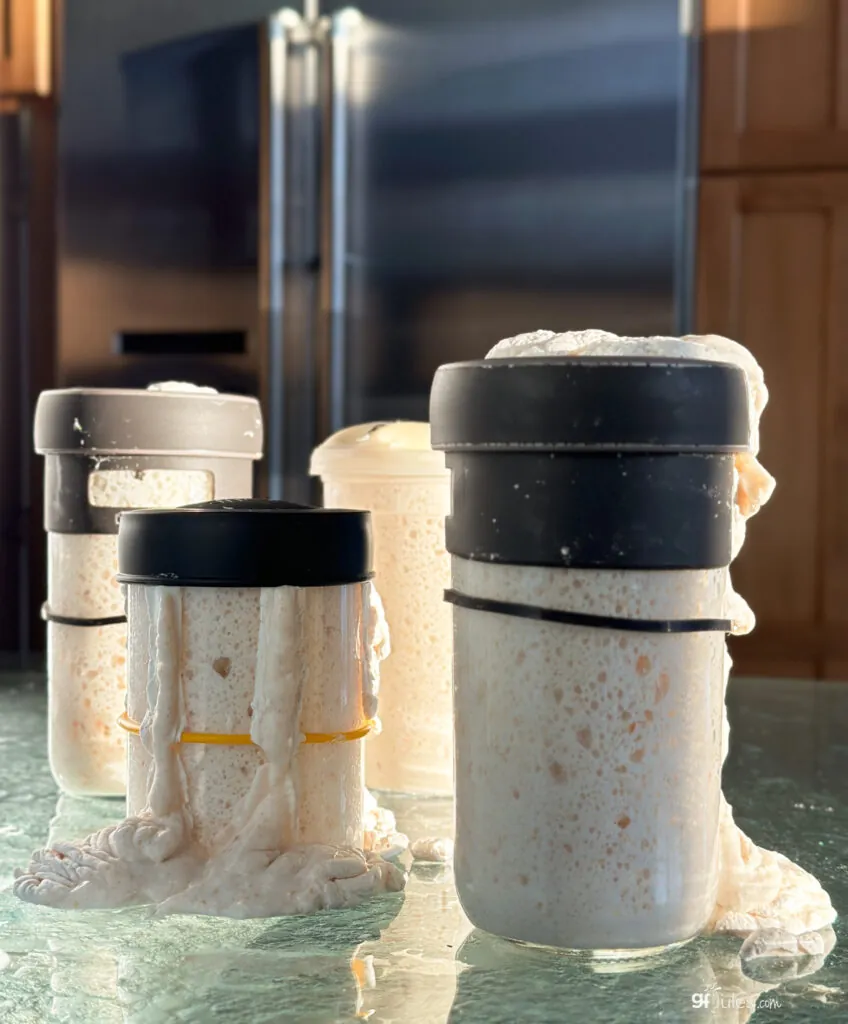
You’ll see when you make this gluten free sourdough starter; you’ll see. You won’t want to discard any of the “extra” either. It’s precious. Here’s how to make your very own gluten free sourdough starter!
Some things are the same about making gluten free sourdough bread as they are with making any other gluten free bread. There’s no kneading the bread and stretching the gluten because there’s no gluten! Just follow my instructions to the letter, use my gfJules Gluten Free All Purpose Flour or gfJules Multigrain Baking Flour and sit back to watch the magic happen.
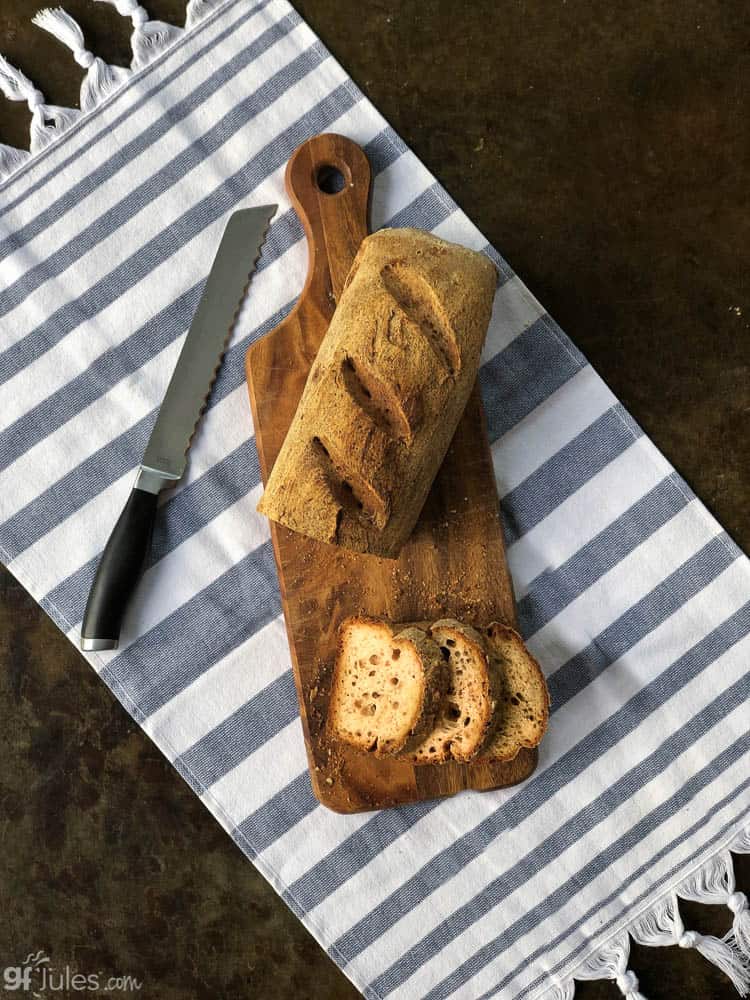
Choosing the Right Gluten Free Flours for Gluten Free Sourdough Bread
In anticipation of many questions to come, this recipe and process was developed using my gfJules Gluten Free All Purpose Flour because it works, I can rely on it every time, it’s easy, and it doesn’t taste funky or have any grit to it. If you try this recipe with another gluten free flour or blend, it really may not work, so please please please don’t even bother to try! But if you do, please don’t leave comments about how it didn’t work, because I’m telling you so before you waste your time.
Gluten free flours are tricky business. It took me two years to develop my original blend way back in 2003 (I’ve been gluten free since 1999!) and I’ve been tweaking and improving it ever since. Just because you think you can read ingredients and intuit how much of anything to use or to buy something off the shelf that sounds similar … you can’t. It won’t be the same, and the results won’t look like those pictured.
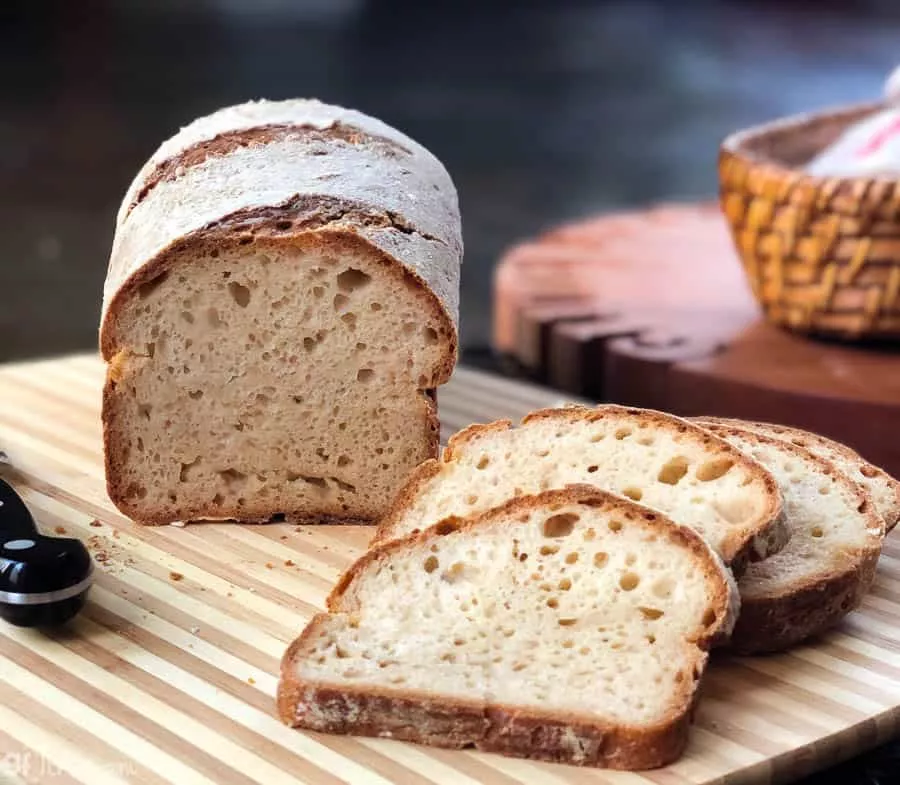
Not to belabor the issue, but tenths of a percentage point difference in proportions and a different brand or country of origin for any given ingredient are things that can make huge changes in outcomes. It amazes me all the time how tiny variances make big differences.
Which is why I developed my gfJules Flour to begin with. Selfishly, I didn’t want to have to make it in my kitchen every time I baked! And unselfishly, I wanted to prevent fellow gluten-free bakers (and newbies to gluten free baking) from having to mess around with mediocre flours only to achieve mediocre results.
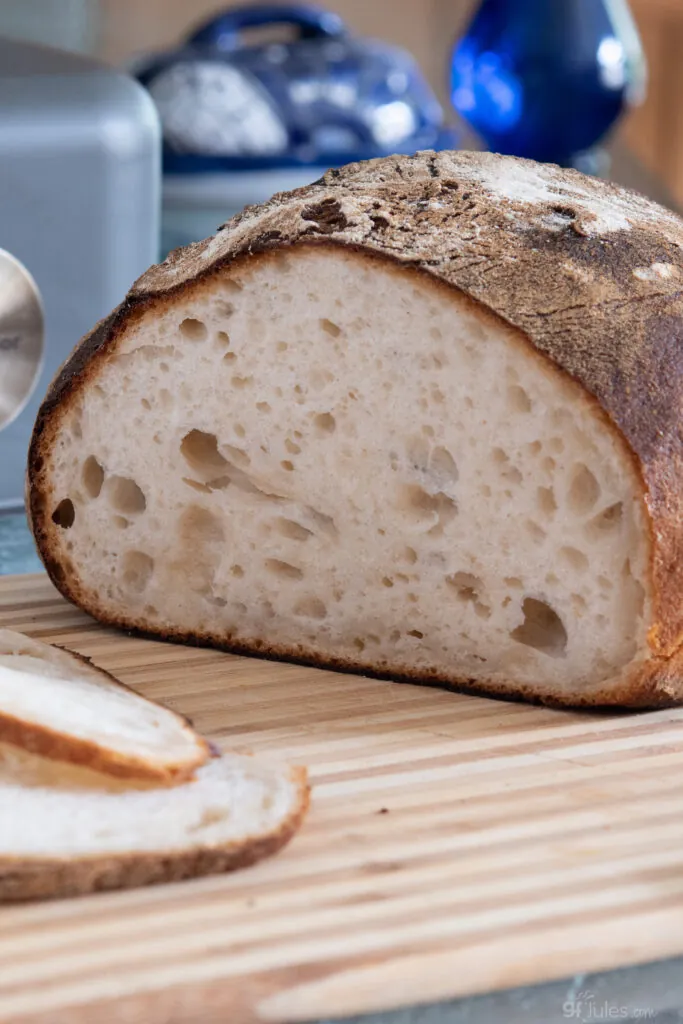
In the process of developing this gluten free sourdough recipe, I learned that my Gluten Free Multigrain Baking Flour is the PERFECT flour for sourdough starter. It goes crazy for it! So if you’re looking for the easiest way to get to gluten free sourdough nirvana, arm yourself with just two gluten free flour blends: gfJules Gluten Free All Purpose Flour and gfJules Gluten Free Multigrain Baking Flour. It’ll make your sourdough baking so much easier!
For more help with gluten free bread baking, in general, hop to my 18 Top Gluten Free Bread Baking Tips.
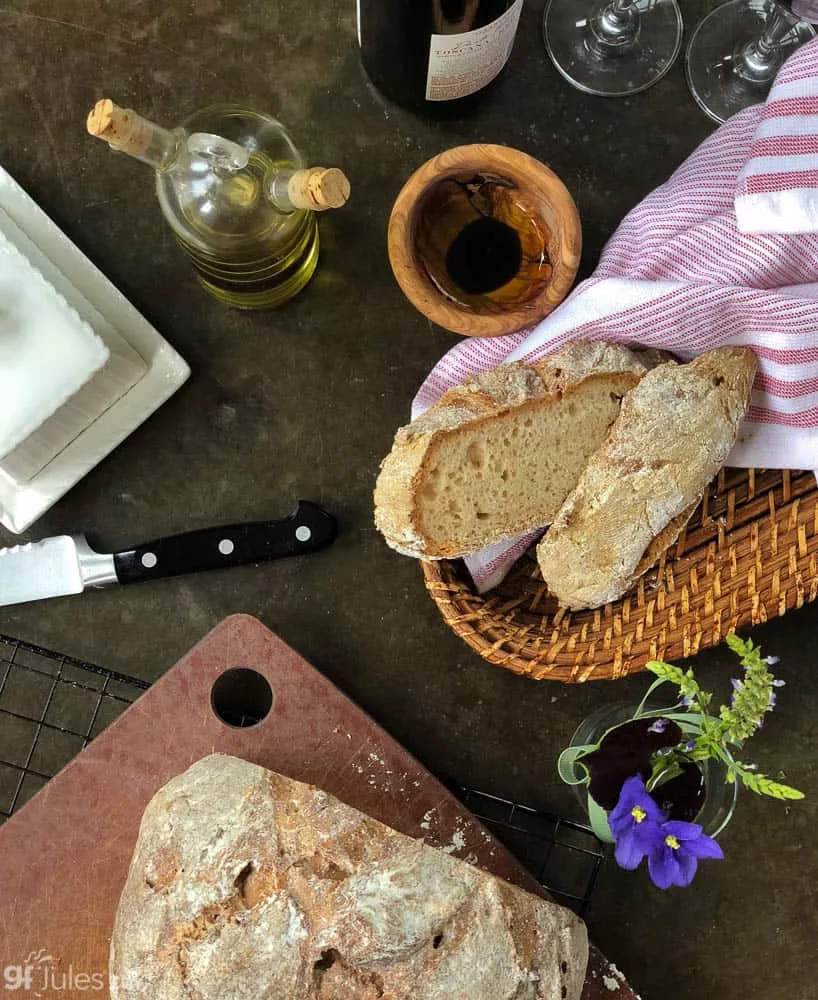
Baking Gluten Free Sourdough — Choosing the Right Pan
As you can see at the top of this post, there are many different options when it comes to baking your gluten free sourdough bread.
Follow along with one reader’s VIDEO of how she made her beautiful gluten free sourdough loaf using with this recipe and this artisan method following clicking here to watch!
Artisan Style Gluten Free Sourdough Bread Method
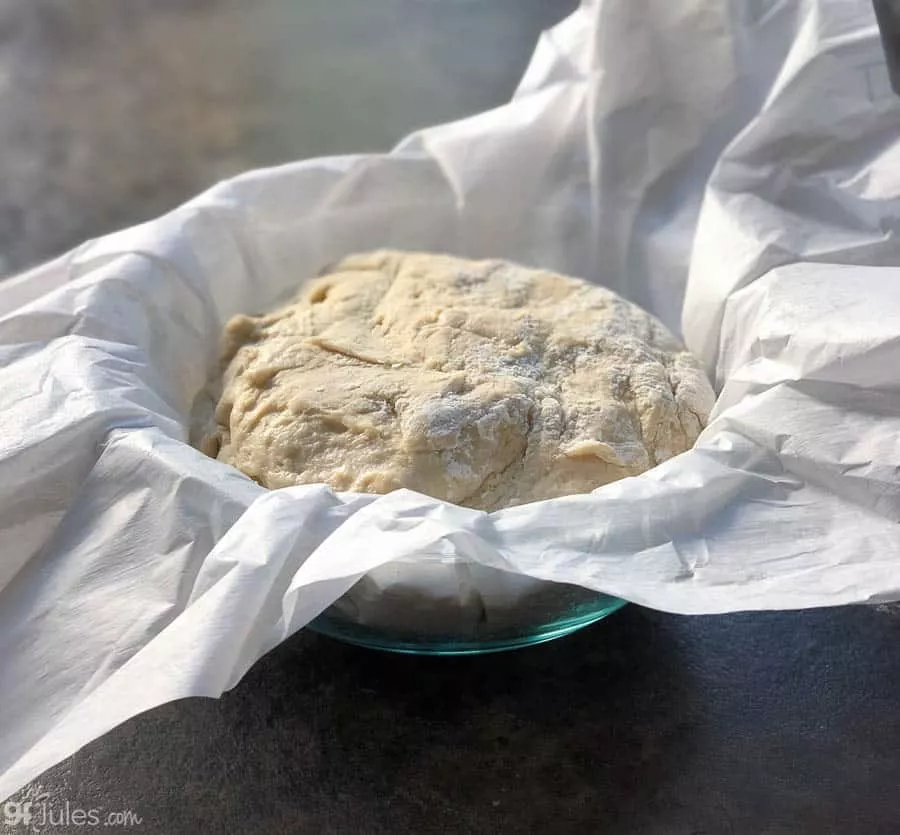
For an artisan-style boule, I prefer lining a banneton (proofing basket) or large glass bowl with oiled parchment sprinkled with more gfJules Flour to support the bread as it rises.
Once risen, I simply lift up on the parchment and lay it out onto a baking sheet for the bread to bake, or put it into a Dutch Oven, or slide onto a baking steel and cover with a baking shell.
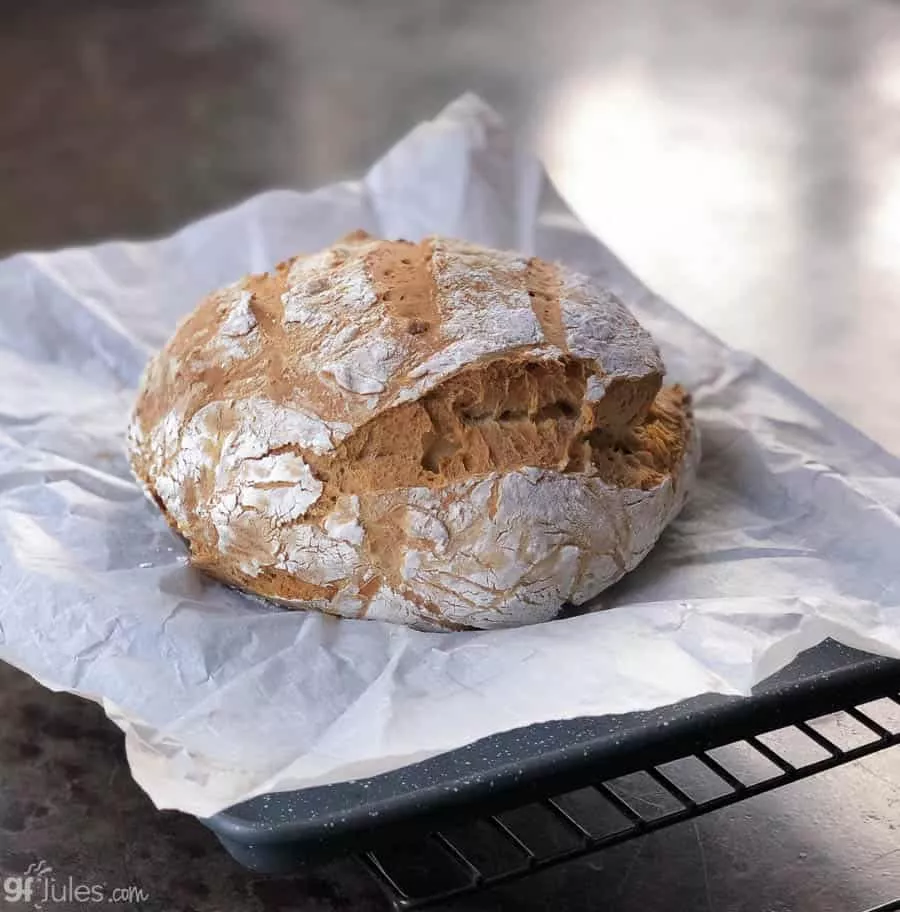
The bread will take more of a free-form shape, but it’s really beautiful and impressive!
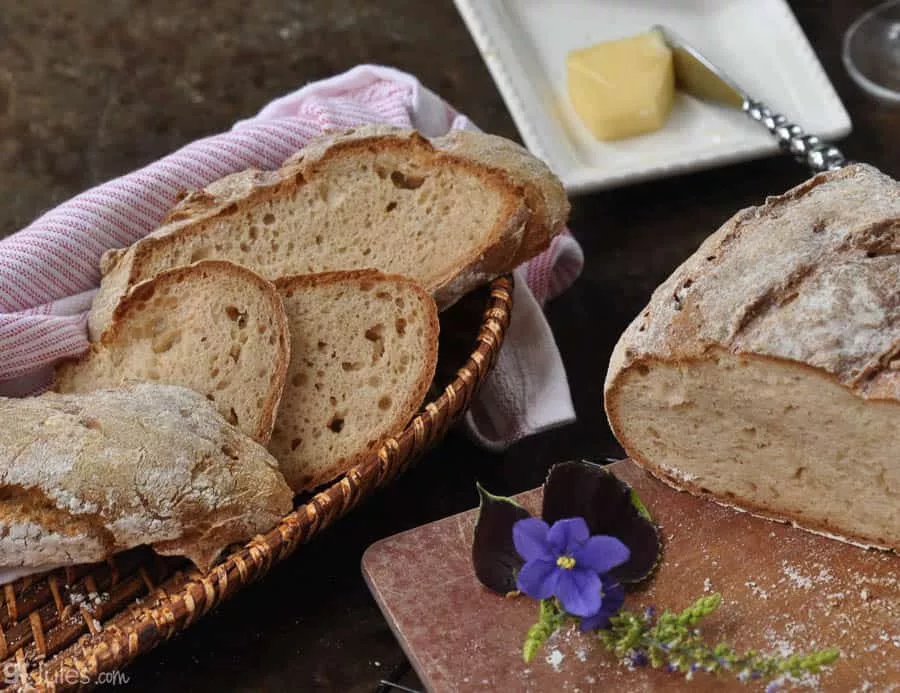
Using either the artisan or bread pan method, you may choose to dust the top of the loaf with gfJules Flour before baking for a more rustic look, or simply brush olive oil onto the top, or both.
Loaf Pan Gluten Free Sourdough Method
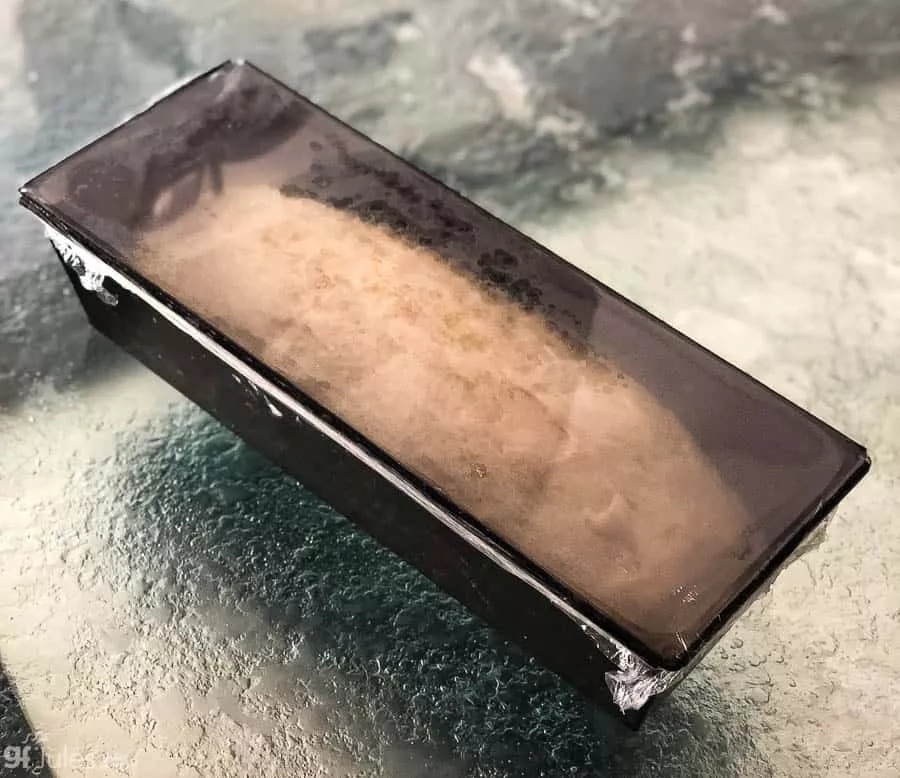
Place the dough into an oiled or parchment-lined pan and brush with oil. Allow the dough to rise covered with oiled plastic wrap to help keep the loaf warm and moist. I like putting the loaf into a preheated 200F oven, then turning the oven off, but turning the light on. I do this with the bread rising in either the bowl or the oiled and floured bread pan.
You can allow the bread to rise here for a minimum of 1 1/2 hours. I find around 2 hours is about right.
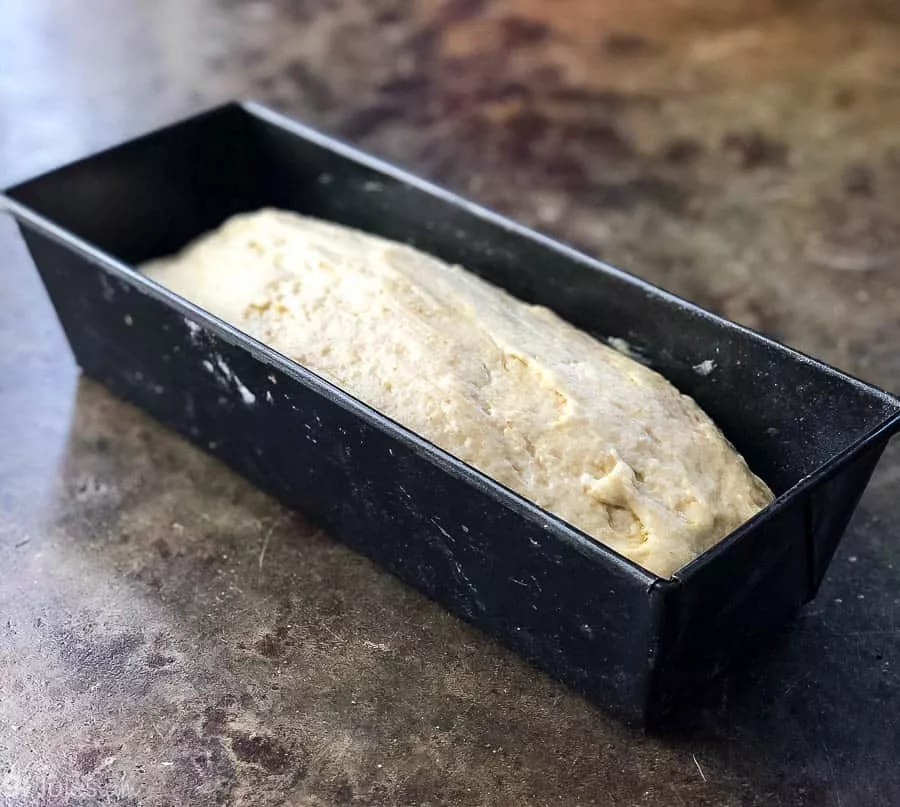
NOTE: The bread won’t have risen a lot, as most of the rising happens when it’s baking.
Feel free to oil and flour the bottom and sides of the pan or use lightly oiled and floured parchment for easier removal from the pan.
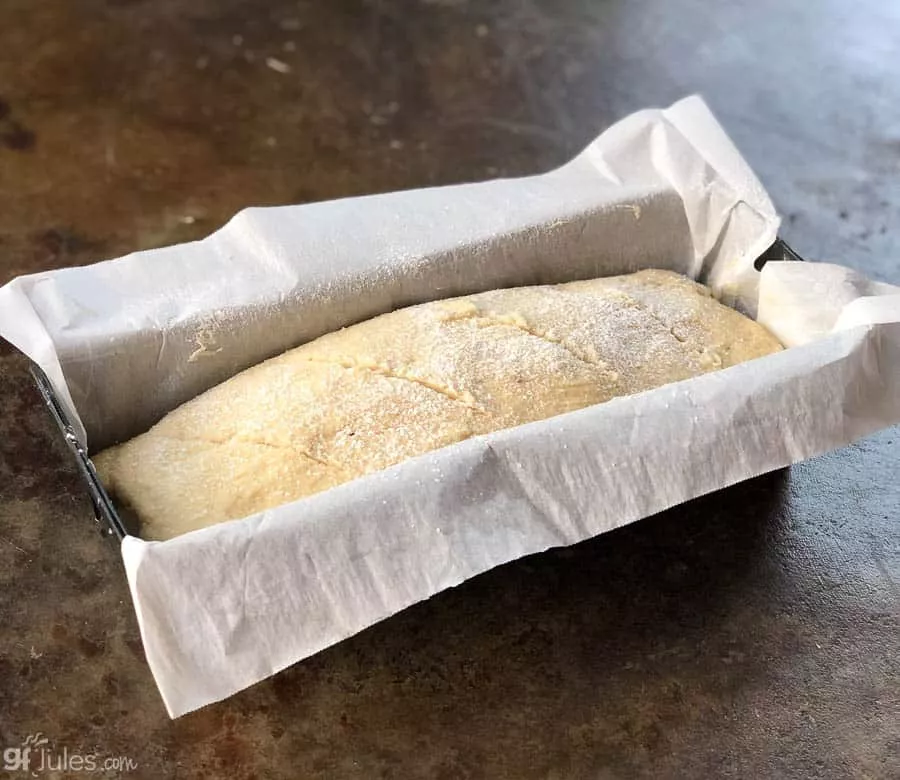
After rising, cut slits in the top of the loaf to direct the rise. Since the oil and/or the flour were applied before the slits were cut, the inside of the slits will appear different from the crust and it gives the sourdough the hand-made look it deserves.
Regarding bread pans, I experimented with all kinds and sizes. For loaves, I really like a Pullman Pan like I used in most of these photos, but a baker with a lid creates a Dutch oven effect which is great for the crust. The bread dough is a bit too voluminous for a traditional 9 x 5 (or smaller) bread pan; in those, this wet dough would rise high and then tended to collapse a bit, leaving some un-cooked looking areas in the center.
The Pullman Pan (mine is 12 x 4 1/2) seemed to be the perfect size to allow the bread to rise with support up the taller sides.

The time it takes to bake this bread will differ based upon the pan used and of course, on individual oven variations. I highly recommend buying an internal thermometer to take the bread’s temperature before removing it from the oven.
The internal temperature should be at least 205F before removing it from the oven to cool.
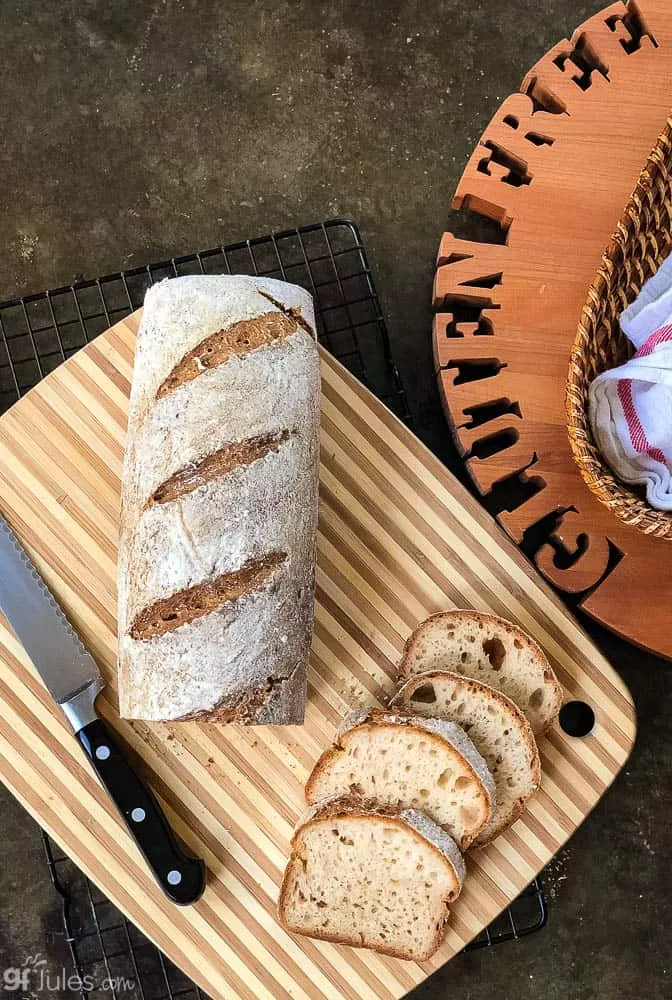
How to Make Gluten Free Sourdough Taste Sour
There are three main distinguishing features of sourdough: taste; smell; and texture. You might expect that the most difficult feature to achieve in gluten free sourdough would be texture, but as you can see from the photos, the artisan texture, open cell structure and crunchy crust are present in each of my loaves made with my gfJules Flour (plus psyllium husk) or my gfJules Bread Mix.
The smell is something that is quite noticeable from the starter. It should be tangy and rather sour smelling to know it’s really active. If your starter isn’t smelling very sour, it needs to age longer and/or be fed more.
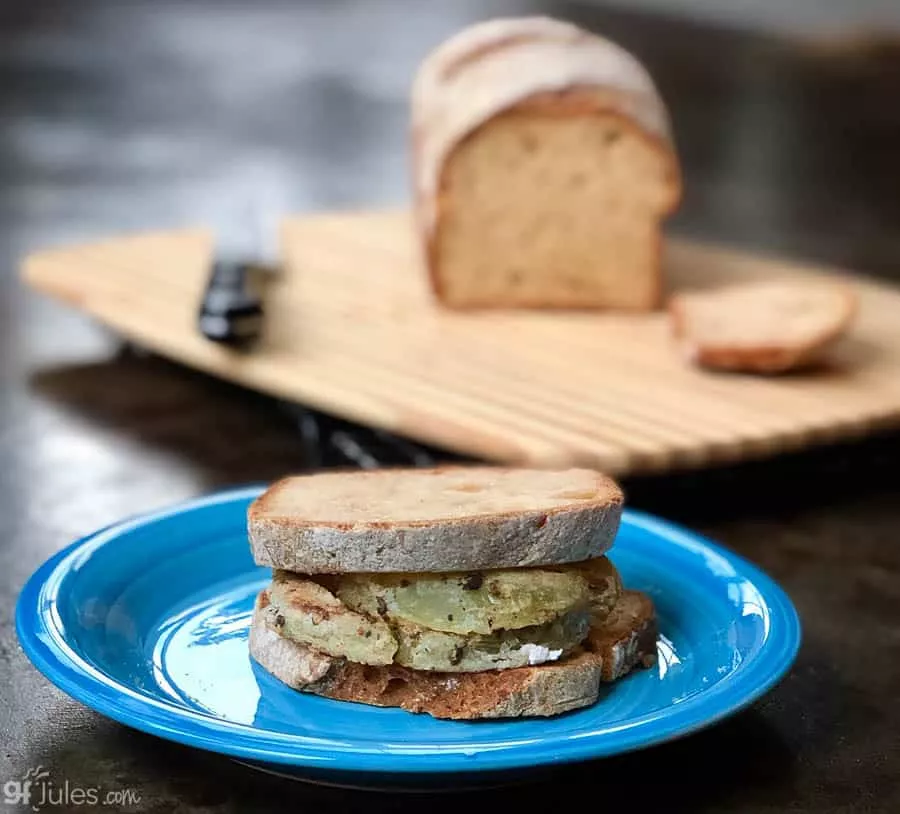
But the sour taste was the thing that seemed to be most elusive for me in my early bread experiments.
My first breads came out tasting yeasty and mild, just perfect for sandwiches or dipping in olive oil and balsamic (which we’ve been doing nearly every night for weeks now!).
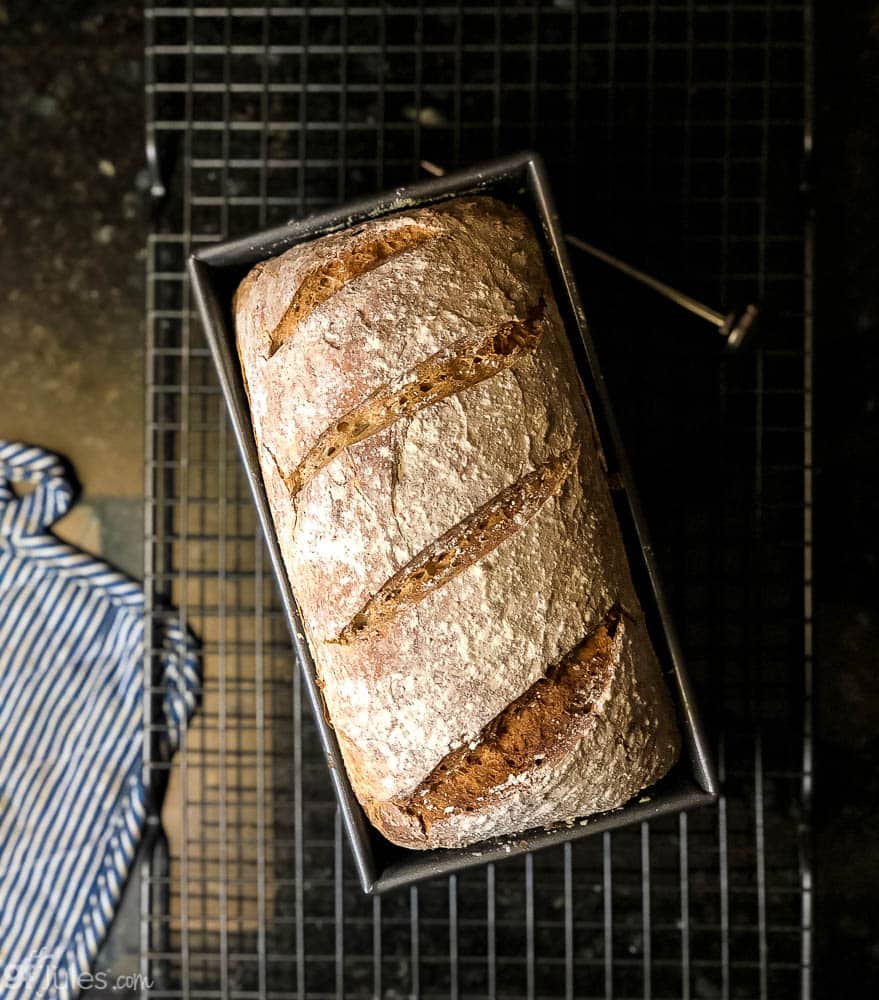
No, the sour taste didn’t come easily. I did achieve it somewhat when I allowed the bread to rise overnight, so if you are searching for that sour, I recommend budgeting time for an overnight rise. But I wanted MORE SOUR. Lucky for you, I cracked the code on that too.
How Do I Make Gluten-Free Sourdough Taste More Sour?
- Overnight Rise. I allowed my bread to rise as I described above, then placed it in the refrigerator overnight (still covered), then removed it the next day to sit on the counter to come to room temperature before baking. THEN the sour started to show through! (note: if you’re baking egg-free, leaving the dough covered in the oven turned off overnight is a good way to get that sour taste.)
- But even more revolutionary, I’ve recently changed my recipe to remove any chemical leaveners (baking powder, baking soda) which altered the pH and allowed the sour flavor to shine through. Those ingredients counteract the sour tang, so adding them negates the sour. This tweak has really made the difference in my gluten free loaves tasting more sour.
- Another site has recommended NOT feeding your sourdough starter again before baking with it in order to increase the sour flavor of the bread. This will also decrease the rise and will necessitate a longer proofing time, however. (Go here for the recipe to make your own gluten free sourdough starter)
- Add more apple cider vinegar. You can always add another tablespoon or two, and reduce the liquid in your recipe to compensate.
If you do any experimenting of your own and find other ways to make this bread taste sour-er, please share in the comments below!
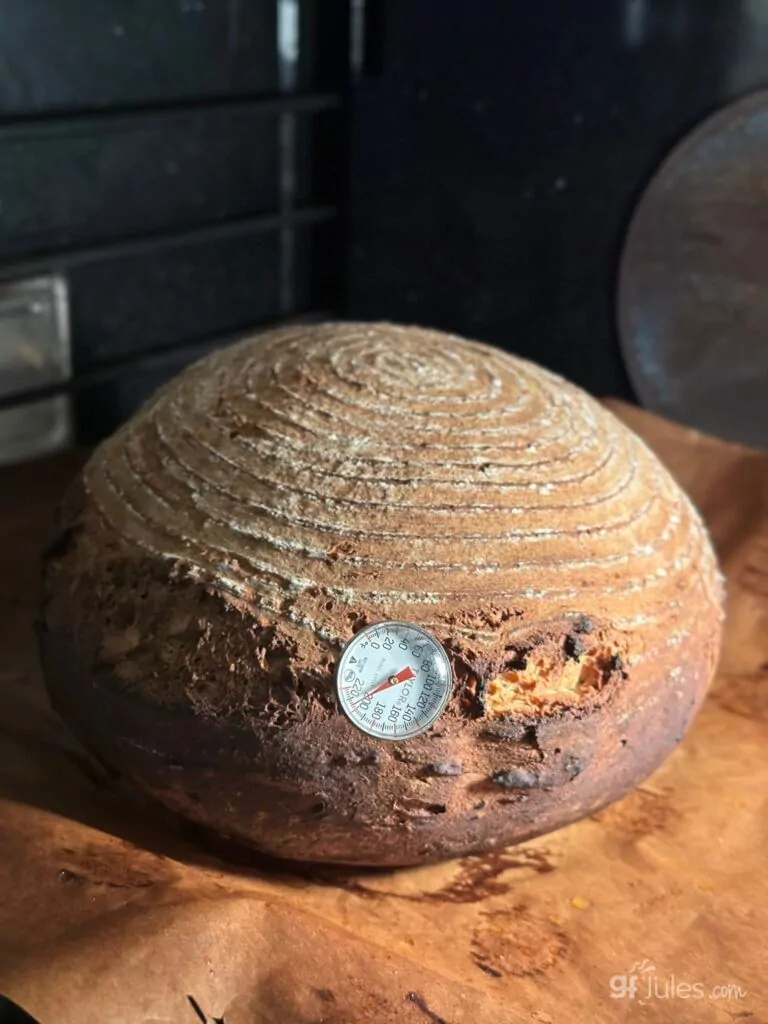
Storing Your Homemade Gluten Free Sourdough Bread
I always recommend storing your baked goods at room temperature in a sealed container, and this gluten free sourdough bread is no exception. The simple truth is that if you put baked goods into the refrigerator, they will dry out. You can put them into the freezer when they are fully cooled, but they will need to be warmed or toasted before enjoying again.
This gluten free sourdough bread is still soft and delicious after a few days in a zip top bag with the air squeezed out of it and stored at room temperature. Depending on the size of your loaf, you may need to cut it in half to get it to fit into a gallon sized bag, but other than that, it’s easy to just seal it up and grab a slice whenever you like! You can also store the bread European-style in a cloth or bread blanket.
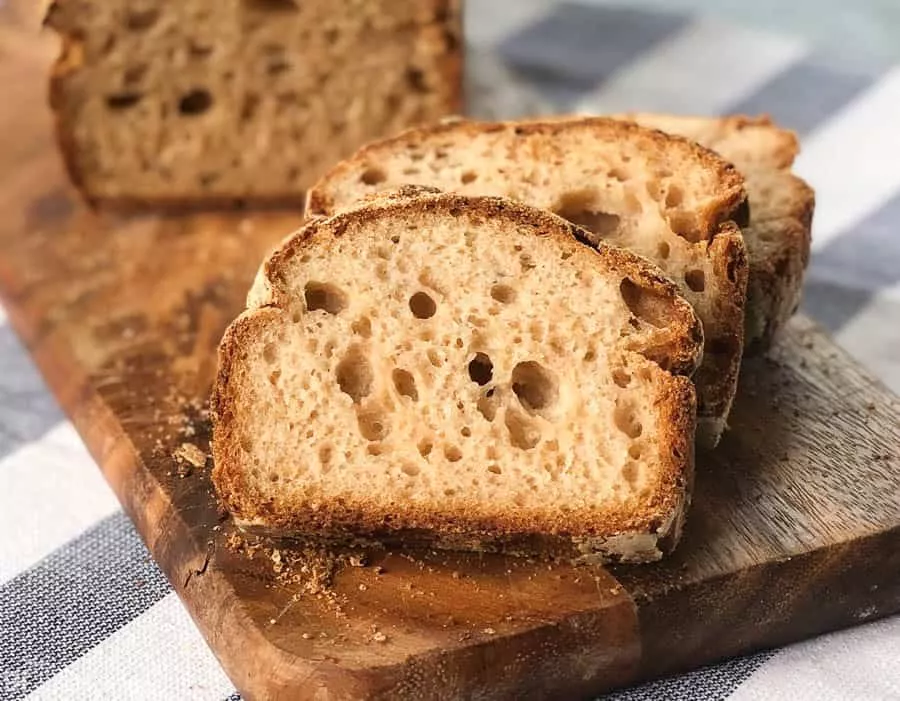
If you’d like to bake a regular gluten free artisan loaf without the sourdough starter, check out my Gluten Free Artisan Bread Recipe. And of course, my award-winning gfJules Gluten Free Bread Mix works well for any kind of sandwich bread, oven or bread machine, hamburger/hot dog bun or baguette recipe! Click on the “description” tab to find links to all these gluten free bread recipes or use the search bar above.
Also note that if you don’t have an aversion to using actual yeast, the best way to get a great rise AND the sourdough taste is to use a little yeast in your bread along with the sourdough starter. In France, in fact, it is permitted to add up to .2% active yeast to sourdoughs and still call the bread a naturally leavened sourdough. You’ll see I’ve recently added an option to add 1 teaspoon active dry or instant yeast to the dough if you’d like to try that method.
So let’s get down to baking great gluten free sourdough, shall we?
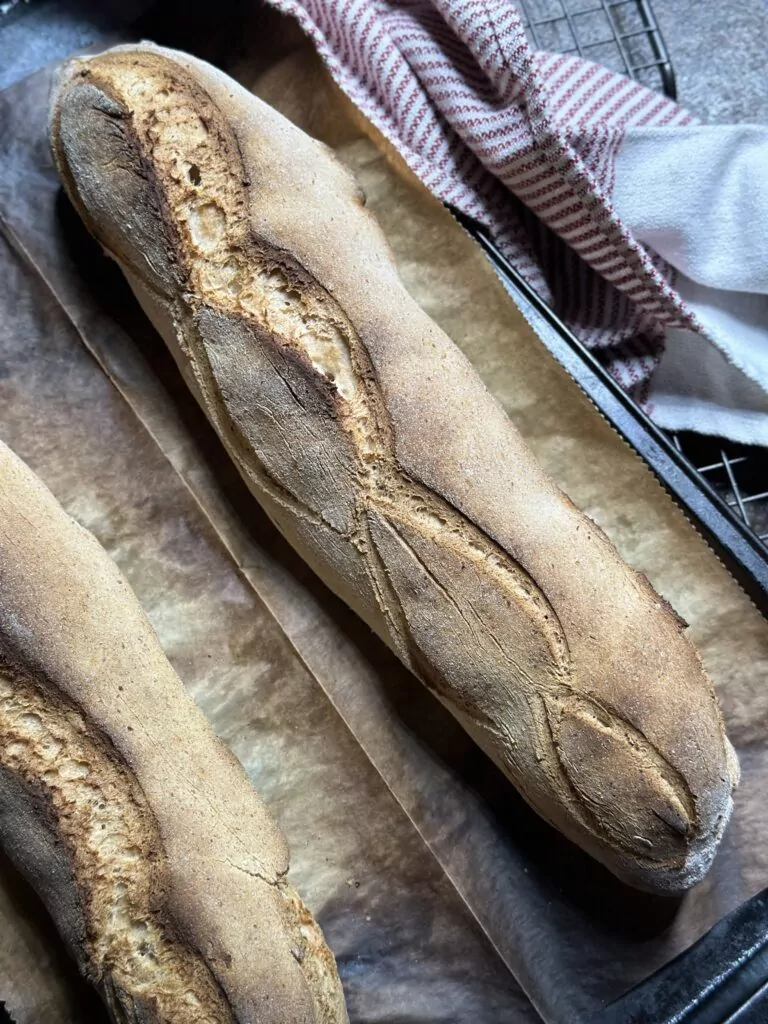
To make a homemade gluten free sourdough starter, hop to this recipe!
Note that this recipe is constantly evolving, the more loaves I bake, the more research I do, and the more feedback I get from you, my readers! What was great gets even better, so keep checking back in for updates to the recipe!
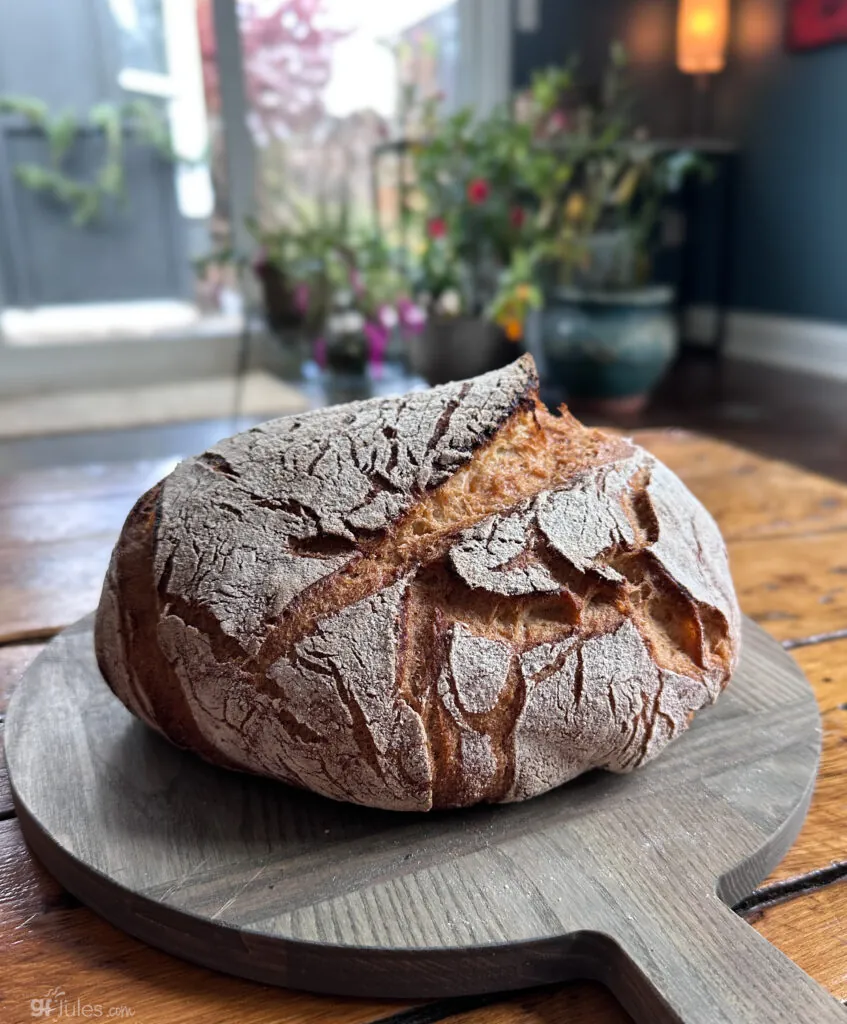
Gluten Free Sourdough Bread Recipe

Gluten Free Sourdough Bread Recipe
Equipment
Ingredients
Sourdough Loaf or Artisan Bread Dry Ingredients
OR
- 3 cups (420 grams) gfJules® Gluten Free All Purpose Flour (for this recipe measure each cup to 140 grams/cup)
- 1/2 cup (70 grams) gfJules Corn-Free Multigrain Flour (OR mixture of buckwheat flour OR cassava flour OR almond meal OR millet flour OR sorghum flour OR coconut milk powder)**
- 2 teaspoons kosher sea salt
- 1 Tablespoon (11 grams) psyllium husk powder optional, but recommended (without psyllium, liquid may need to be reduced by 2-4 Tbs. if dough is too loose)
- 1 teaspoon rapid rise yeast or active dry yeast like Red Star (this is OPTIONAL, but recommended, especially if using young starter or less rise time)
PLUS These Other Ingredients
- 2 Tablespoons apple cider vinegar
- 1/4 cup (56 grams) sugar
- 3/4 cup (185 grams) active gluten free sourdough starter (feed ~6 hours before)
- 1 1/2 cup bubbly liquid like club soda, sparkling water, ginger ale OR naturally gluten free beer
Instructions
- Bring all ingredients to room temperature.
- Preheat oven to 200°F if rising there.
- Stir the following ingredients together in a large mixing bowl: apple cider vinegar, sugar, psyllium husk powder, and gluten-free sourdough starter. Mix until smooth and thickened, approximately 2 minutes.
- In a separate bowl, whisk together remaining dry ingredients, then slowly add into the large mixing mixing bowl together with bubbly liquid. Use the paddle attachment on a stand mixer or a dough mixer hand tool. Mix until dough comes together. (If adding active yeast, proof before adding.) Mix for two minutes with mixer, longer if by hand.
- Transfer dough to a clean counter or pastry mat dusted well with gfJules Flour. Turn dough several times in flour to smooth the dough and shape into a ball or a log for a loaf pan.
If Baking in Loaf Pan:
- Transfer dough to an oiled or parchment-lined Pullman Pan or 9x5 loaf pan, lightly dusted with gfJules Flour, or to floured parchment-lined pan or bowl for rising. Spritz with water, brush with olive oil, and dust the top of the dough with more gfJules Flour for best results.
- Cover with oiled plastic wrap and set inside warmed oven. Turn oven off and turn light on.
- Allow the dough to rise for at least 1 1/2 hours, or up to 3 hours before baking. Alternatively, after 3 hours, remove to refrigerator for further overnight rise. If refrigerating overnight, bring the dough to room temperature before baking the next day.
- Preheat oven to 350° F or 325° F convection.
- Remove plastic wrap and slice across the top of the dough as pictured to direct the rise.

- If you prefer a very crunchy crust, fill a spray bottle with water and spritz the dough again before baking, and again every 15-20 minutes while baking.
- Bake loaf in the pan for 75 minutes and test with a bread thermometer. The internal temperature should reach at least 205° F before removing to cool. If the bread is browning too much, cover with foil in order to keep baking.
- Once bread is fully cooked, remove to cool on a wire rack for 15 minutes before removing from the pan. Allow to fully cool before slicing.

If Baking Artisan Bread:
- Transfer to a proofing basket or oiled parchment-lined glass bowl.
- Cover loosely with a warm, damp tea towel or oiled cling wrap and place in a warm spot to rise for 1 - 3 hours before baking. Alternatively, after rising, remove to refrigerator for further overnight rise. If refrigerating overnight, bring the dough to room temperature before baking the next day.
- Invert gently onto a parchment lined baking sheet and remove basket or bowl. Cut a slice across the top at an angle with a lame or sharp knife before baking.

If Baking in Dutch Oven or Using Baking Shell:
- Place Dutch Oven inside oven and preheat oven to 500°F. If using a baking steel and shell method, place the baking steel on the oven rack to preheat (no need to preheat the baking shell).Once the Dutch Oven is preheated, remove lid and place parchment with dough boule inside, spritz with water, then replace the lid and put the Dutch Oven back inside the oven. If using baking shell, transfer loaf onto parchment and slide onto hot steel in the oven (using a pizza peel helps here) then cover with baking steel.Bake for 20 minutes covered, then remove the lid and reduce the oven temperature to 450°F and bake for 25 more minutes. *To prevent the bottom of the loaf from burning, place an oven safe pan at least the diameter of your Dutch Oven or steel on the rack just below and fill with ice cubes. This will provide both steam and a buffer between the heating element and the bottom of the pan.*

If Baking On Baking Sheet:
- If baking without pan, place bread on parchment lined pan in 500°F preheated oven, then immediately reduce the temperature to 450°F and bake for 35 minutes, test internal temp and continue to bake if needed -- bake until bread is browned and internal temperature reaches at least 205°F. *To prevent the bottom of the loaf from burning, place an oven safe pan at least the diameter of your bread on the rack just below your baking pan and fill with ice cubes. This will provide both steam and a buffer between the heating element and the bottom of the pan.*

- Using either method, once the bread is baked, turn the oven off but leave the bread inside the oven with the oven door cracked for another 20 minutes before removing. Allow to fully cool before slicing to prevent any gumminess.
Video
Notes
- 56 grams sugar
- 2 Tbs. apple cider vinegar
- 3/4 cup active sourdough starter (fed ~6 hours earlier)
- 1 1/4 cup warm water
** Please keep in mind that nutrition information provided is per serving, which may vary. While we have taken care to provide you with the most accurate nutritional values possible, please note that this information may differ significantly depending on the exact ingredients and brands that you choose to use to make this recipe. Additionally, where options are given for ingredients, the resulting calculation may include all ingredient options instead of only one per line, skewing the totals significantly.
Recommended Products
Any links to Amazon may earn me a small amount from qualifying affiliate purchases; this amount goes to fund this blog and does not cost you anything additional.

Viva Naturals

Bragg Live Food Organic Apple Cider Vinegar 946ml/32fl oz

Regency Wraps RW450N, 9 Sq. ft, Natural

gfJules All Purpose Gluten Free Flour

Norpro NOR-3952 12" Bread PAN, Non-Stick, 12 inch

Empty Amber Glass Spray Bottles with Labels (2 Pack) - 16oz Refillable Container for Essential Oils, Cleaning Products, or Aromatherapy - Durable Black Trigger Sprayer w/Mist and Stream Settings

gfJules Gluten Free Sandwich Bread Mix
Can I Make GRAIN Free Sourdough?
I’ve been getting this question a lot lately. Grain-free blends are very different from gluten free flour blends, and they behave differently in yeast breads. BUT … I have developed a mostly GRAIN-FREE Sourdough variation that is quite lovely with my gfJules Nada Flour.
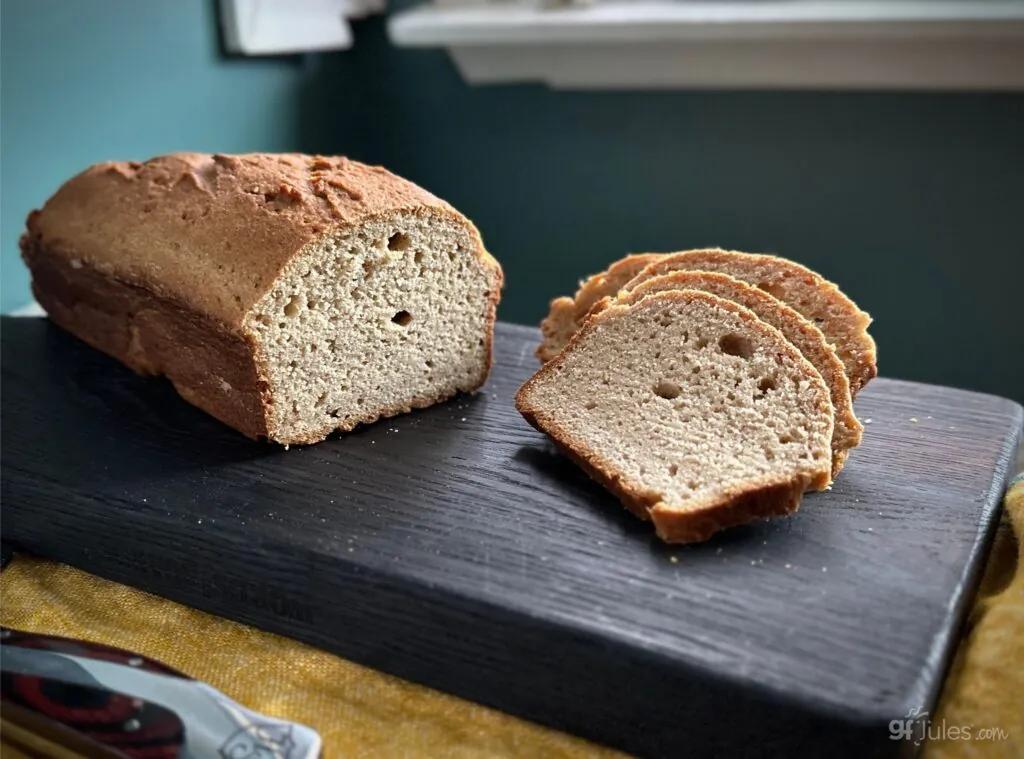
Of note: the starter I used was based on my gfJules Multigrain Flour, so it does contain grains, thus, this loaf is not entirely grain-free.
I have not yet had time to develop a grain-free starter. Alas, I am but one baker. Someday ….
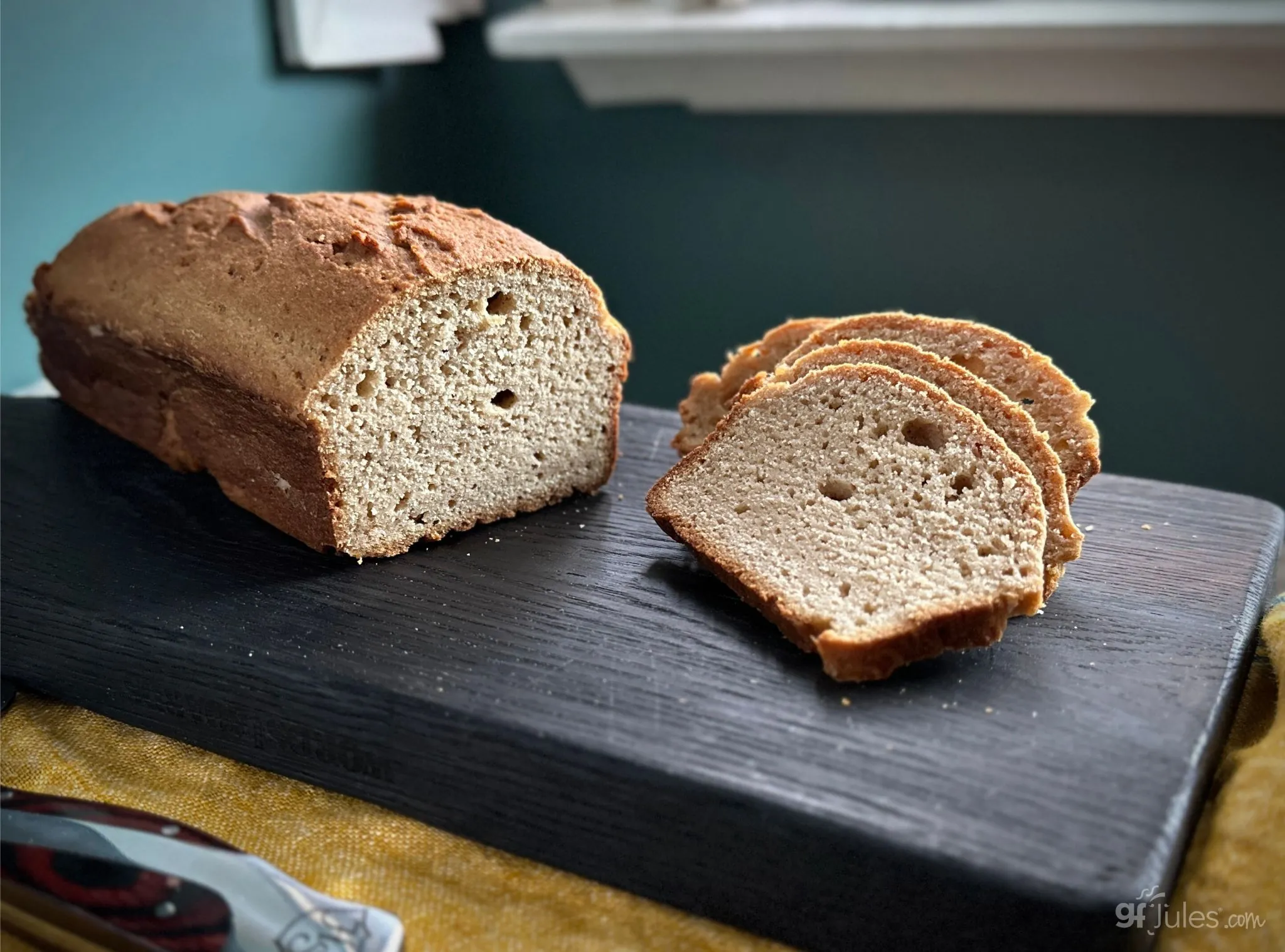
Mostly GRAIN Free Sourdough Bread Recipe
Ingredients
Sourdough Loaf or Artisan Bread Dry Ingredients
PLUS These Other Ingredients
- 2 large eggs OR 2 Tbs. flaxseed meal steeped 10 minutes in 6 Tbs. warm water
- 2 Tbs. apple cider vinegar
- 1/4 cup olive oil
- 1/4 cup 56 grams sugar
- 1 cup gluten free sourdough starter
- 1 cup club soda sparkling water, ginger ale, 7-Up, naturally gluten free beer, OR still water
Instructions
- Bring all ingredients to room temperature.
- Preheat oven to 200°F.
- Beat the following ingredients together in a large mixing bowl: eggs (or substitute), apple cider vinegar, oil, sugar, and gluten free sourdough starter. Mix until smooth.
- Slowly stir in dry ingredients with liquid, beating with paddle attachment on a stand mixer or using a wooden spoon until the batter is smooth and all dry ingredients are completely integrated. Mix for two minutes with mixer, longer with spoon method.
If Baking in Loaf Pan:
- Transfer dough to an oiled Pullman Pan or 9x5 loaf pan, lightly dusted with gfJules Nada Flour. Dust the top of the dough with more gfJules Nada Flour.
- Spritz with water and cover with oiled plastic wrap and set inside oven. Turn oven off and turn light on.
- Allow the dough to rise for at least 1 1/2 hours, or up to 3 hours before baking. Alternatively, after 3 hours, remove to refrigerator for further overnight rise. If refrigerating overnight, bring the dough to room temperature before baking the next day.
- Preheat oven to 425° F.
- Remove plastic wrap and slice across the top of the dough to direct the rise.
- If you prefer a very crunchy crust, fill a spray bottle with water and spritz the dough before baking, and again every 15-20 minutes while baking.
- Place uncovered loaf pan in oven, then reduce temp to 350° F. Bake loaf in the pan for 75 minutes before testing with a bread thermometer. The internal temperature should reach at least 205° F before removing to cool. If the bread is browning too much, cover with foil in order to keep baking. Bake for full 75 minutes, even if bread has reached internal temp earlier.
- Once bread is fully cooked, remove to cool on a wire rack for 15 minutes before removing from the pan. Allow to fully cool before slicing.
** Please keep in mind that nutrition information provided is per serving, which may vary. While we have taken care to provide you with the most accurate nutritional values possible, please note that this information may differ significantly depending on the exact ingredients and brands that you choose to use to make this recipe. Additionally, where options are given for ingredients, the resulting calculation may include all ingredient options instead of only one per line, skewing the totals significantly.
Recommended Products
Any links to Amazon may earn me a small amount from qualifying affiliate purchases; this amount goes to fund this blog and does not cost you anything additional.

Viva Naturals

Bragg Live Food Organic Apple Cider Vinegar 946ml/32fl oz

Regency Wraps RW450N, 9 Sq. ft, Natural

gfJules All Purpose Gluten Free Flour

Norpro NOR-3952 12" Bread PAN, Non-Stick, 12 inch

Empty Amber Glass Spray Bottles with Labels (2 Pack) - 16oz Refillable Container for Essential Oils, Cleaning Products, or Aromatherapy - Durable Black Trigger Sprayer w/Mist and Stream Settings

gfJules Gluten Free Sandwich Bread Mix
Many thanks to the indomitable Chef Patrick Auger for his help in developing this original recipe years ago. His passion for baking allergen-friendly foods has helped many a baker achieve amazing gluten free results like these!
I can’t wait to hear about your gluten free sourdough bread baking!
Pin for later!

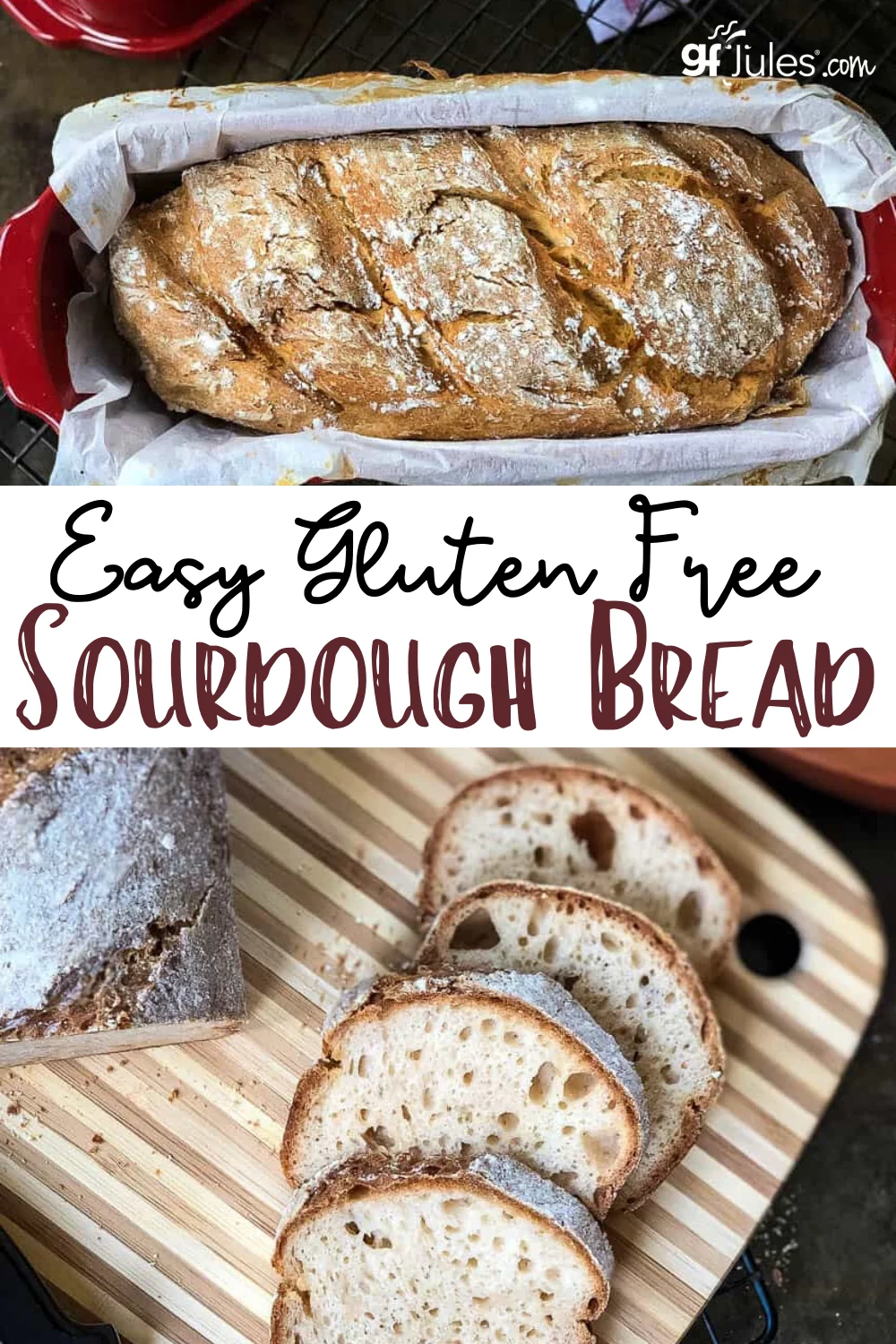
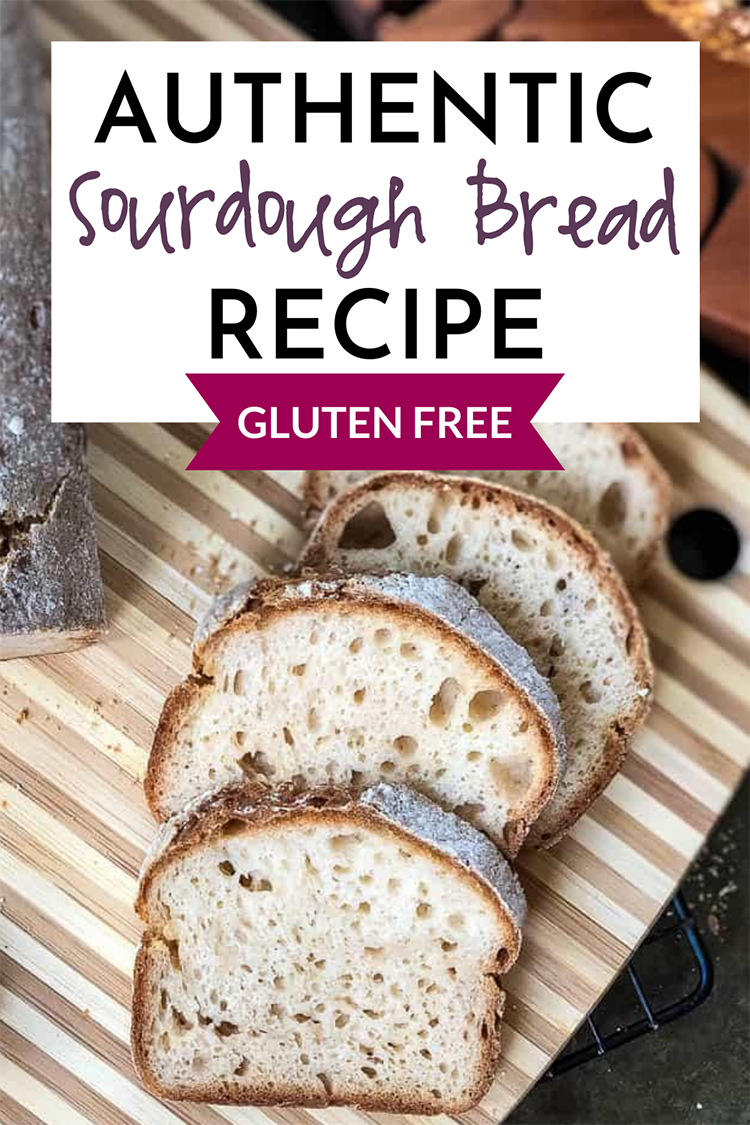
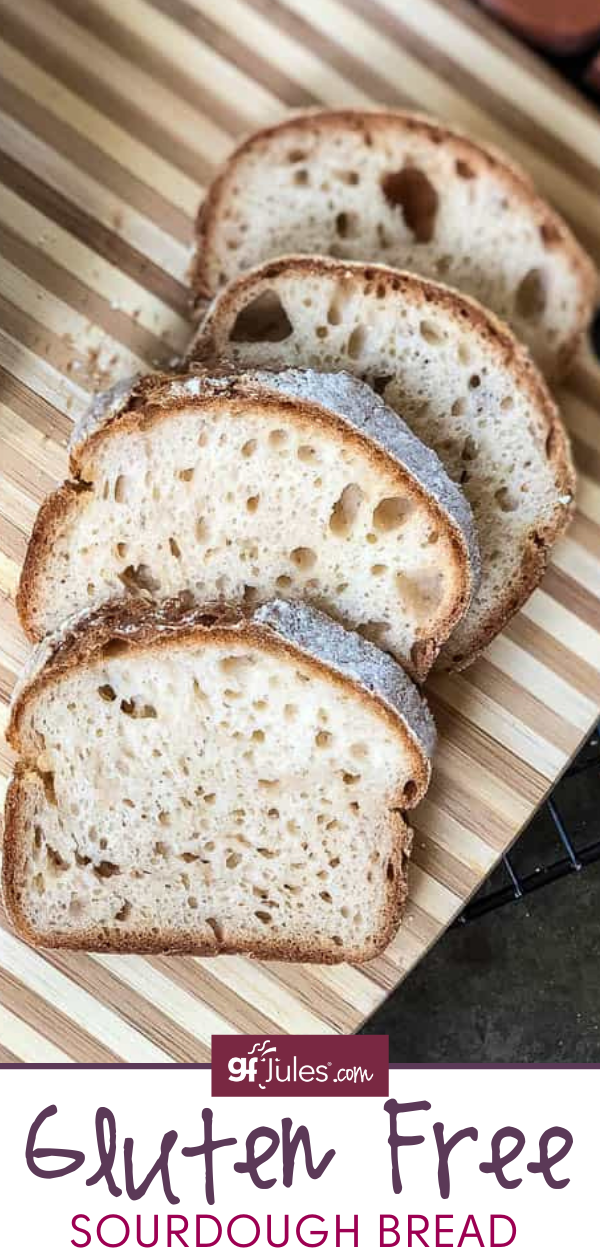
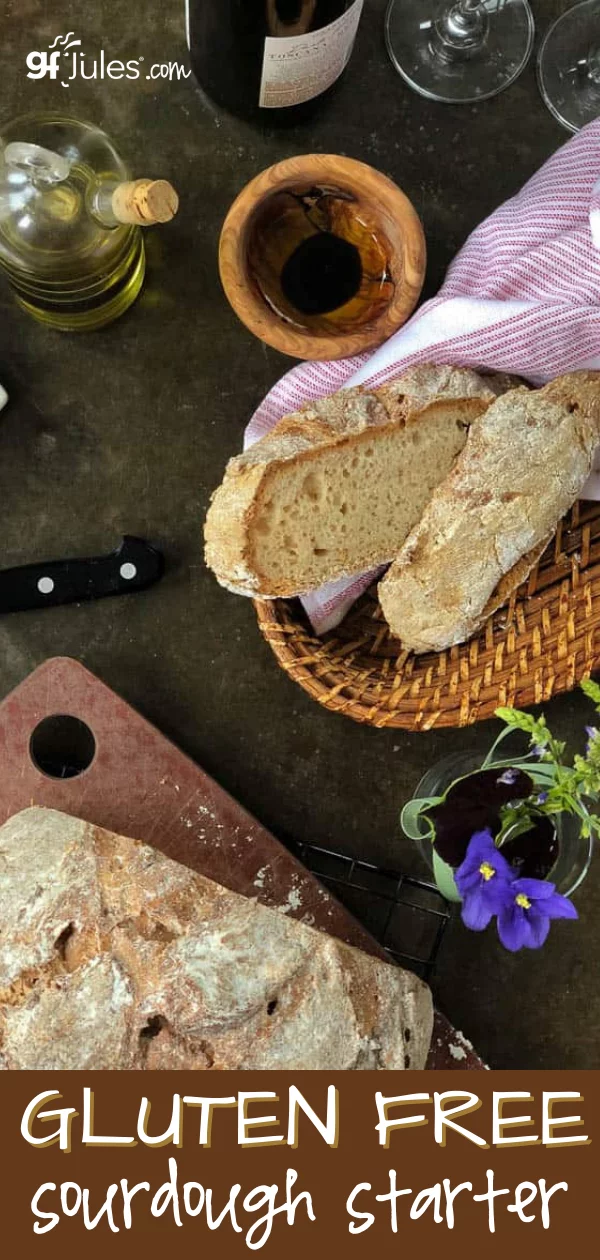
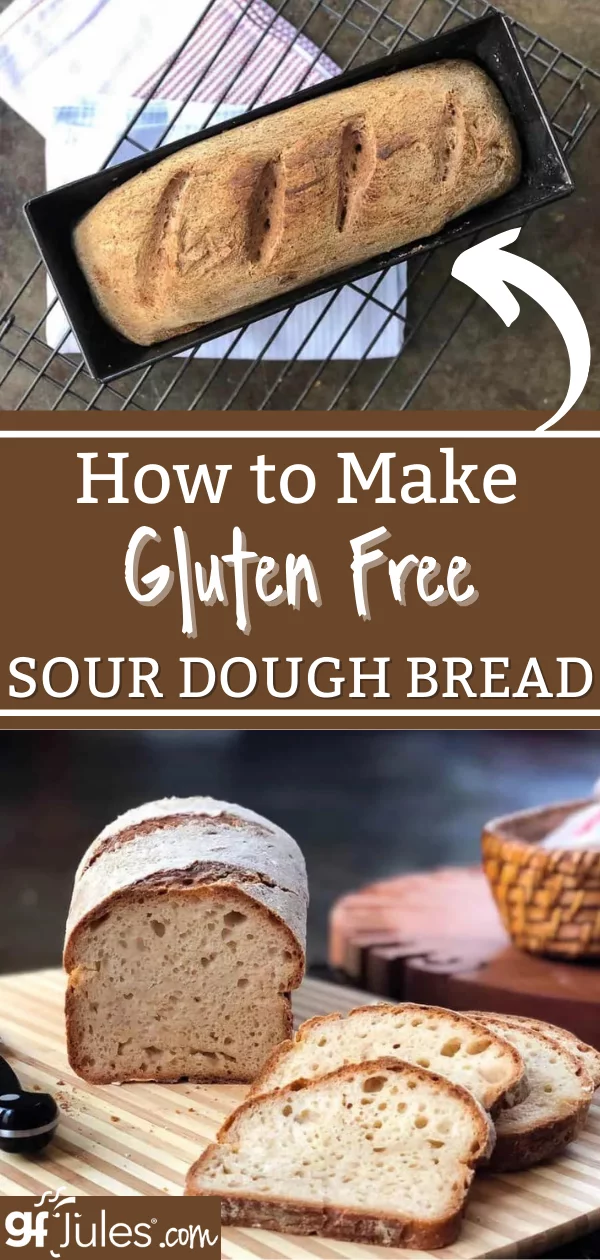



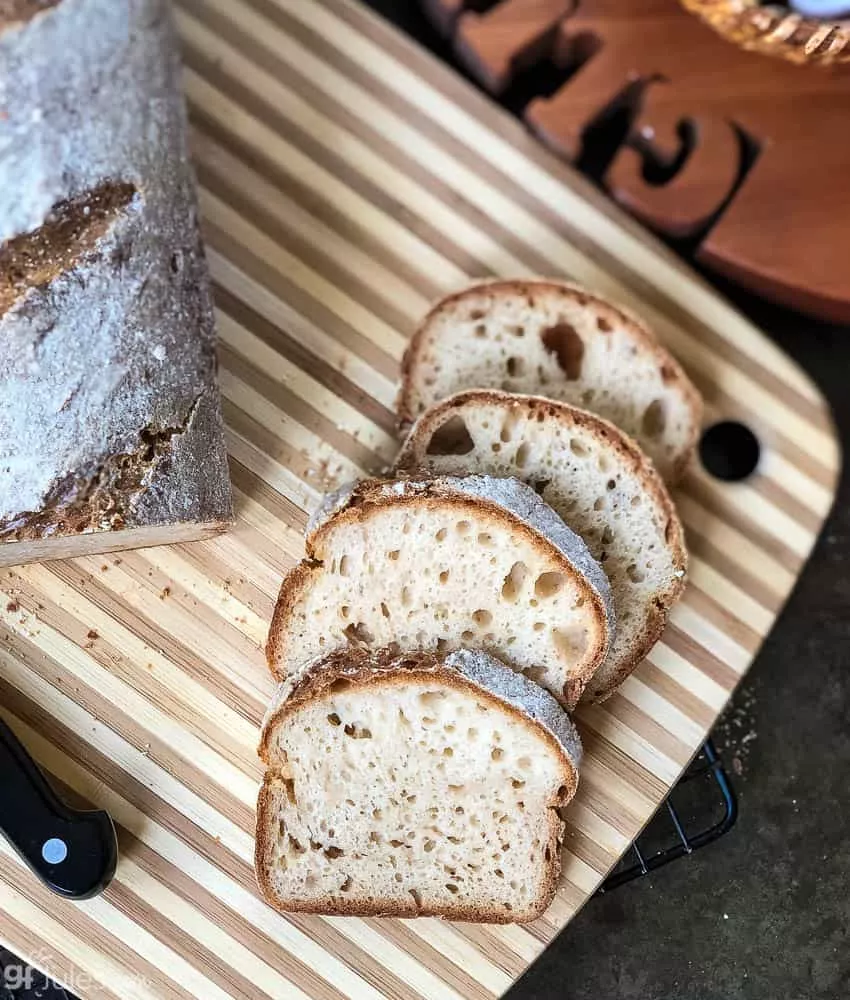
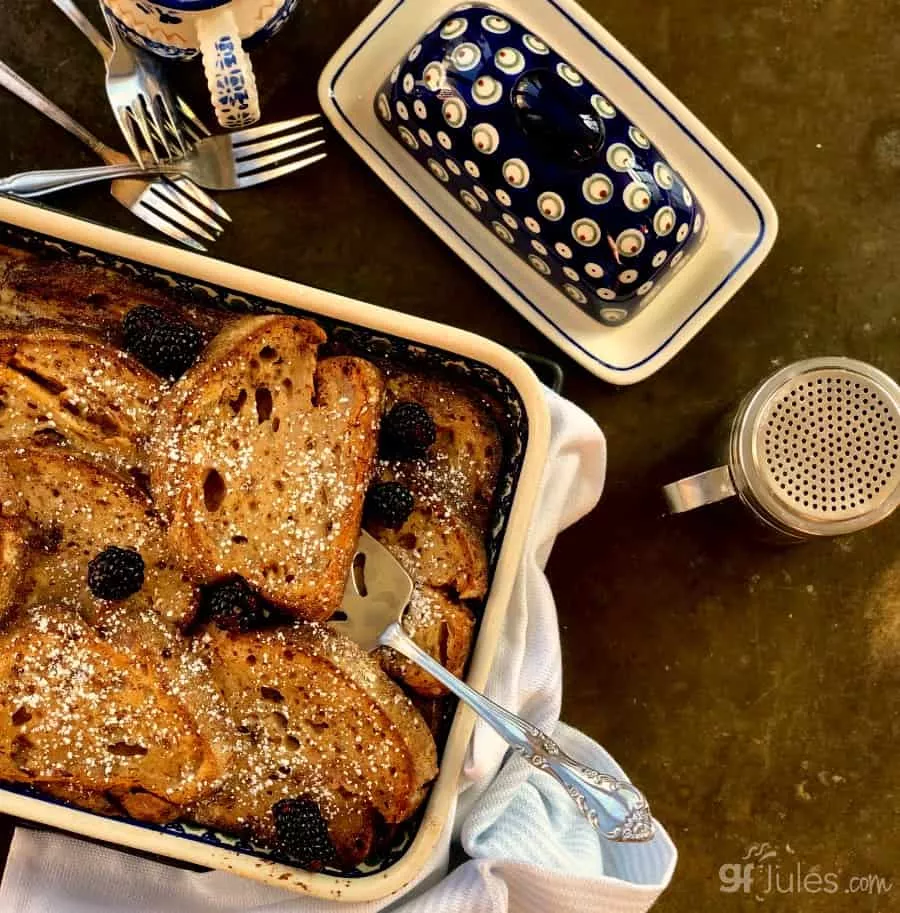
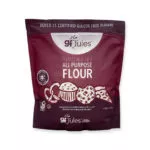
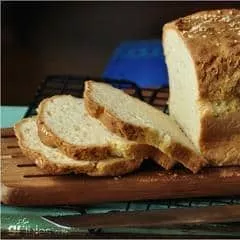
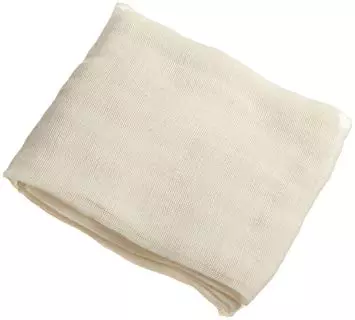
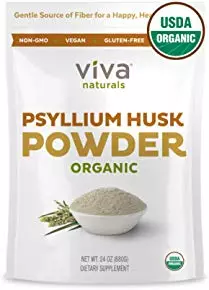

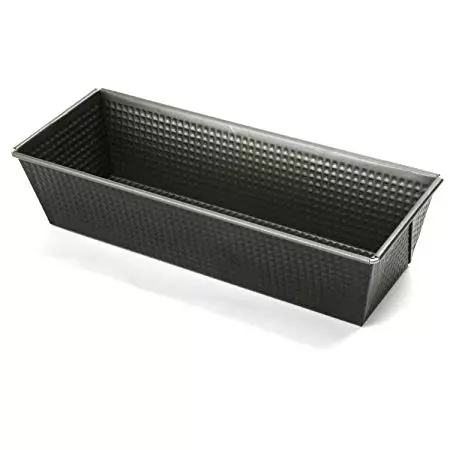
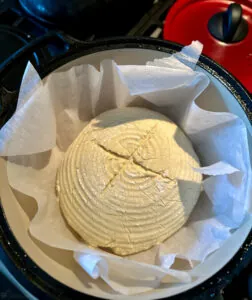
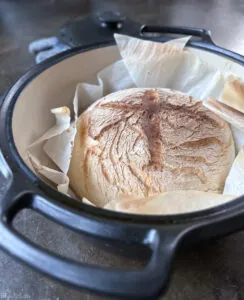


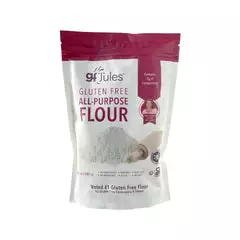











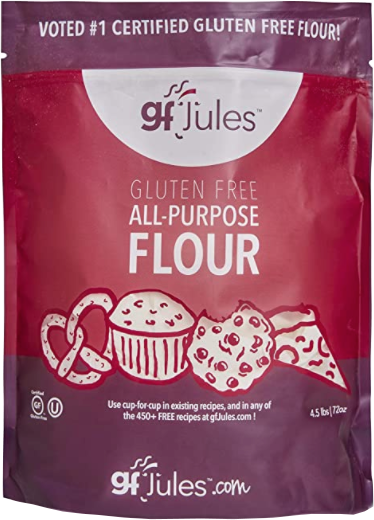
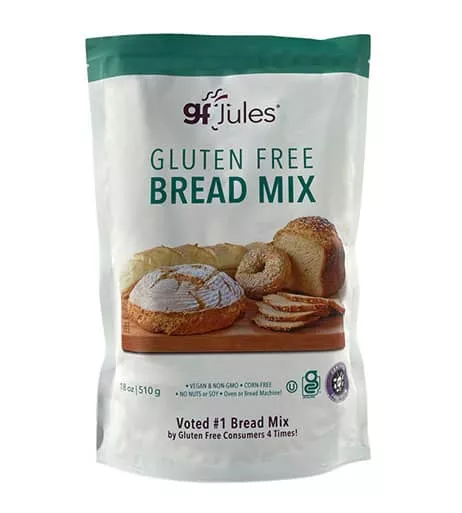
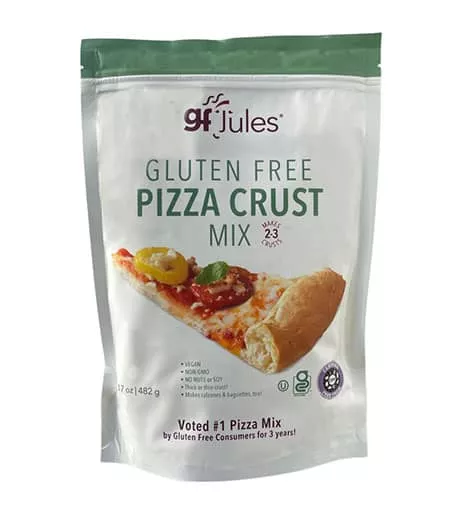
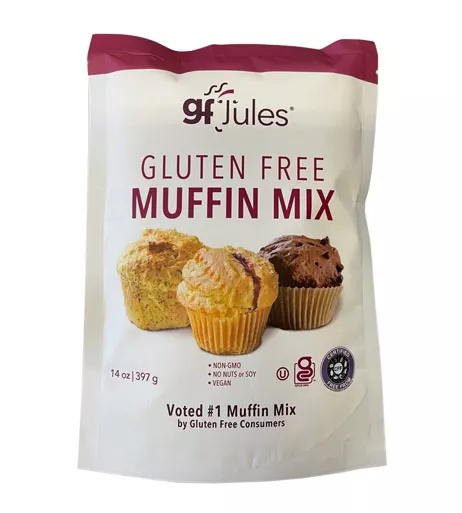
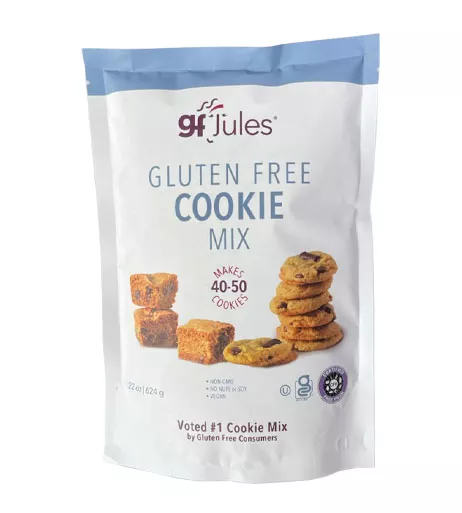

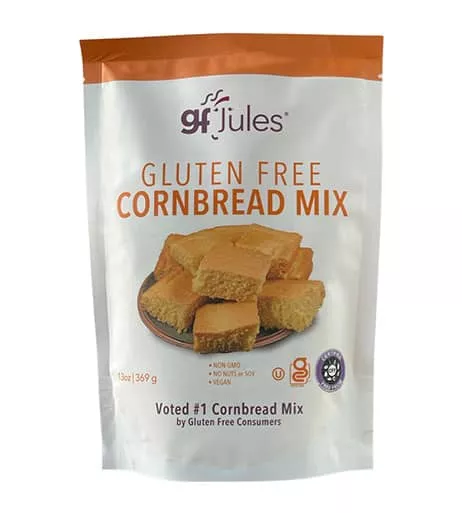



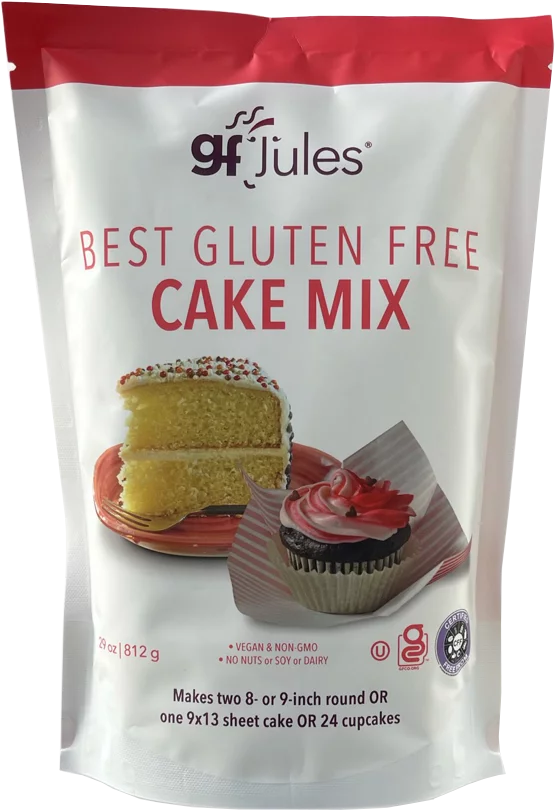
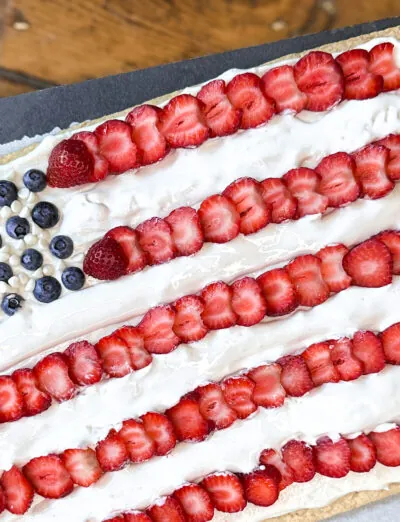

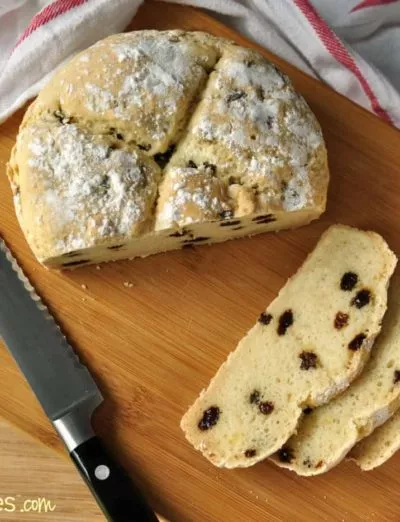
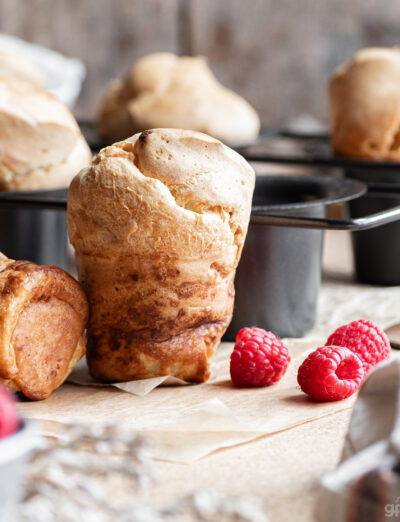


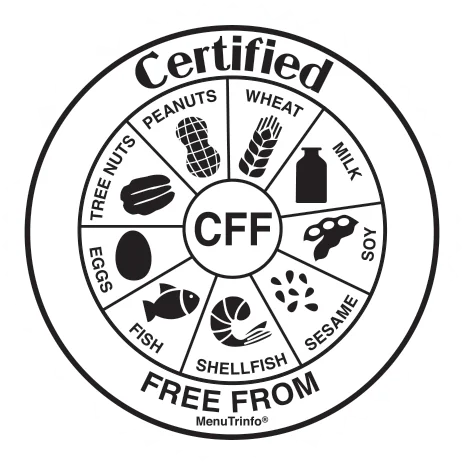

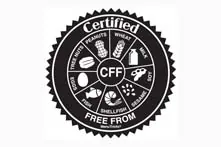
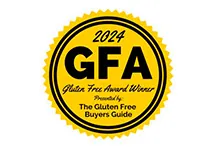

Another successful recipe! So easy to follow. I’ve been so intimidated by baking gluten free sourdough but I’m so happy how my first loaf came out! I feel like I could have kept it cooking for alittle longer, but other than that it really did taste like regular bread! I used your starter AND bread mix to make this! 🙂 thank you!!
YAY!!!! Sending you so many high fives from here! It’s gorgeous! Way to go for diving right in and trying gluten free sourdough without intimidation! You should be so proud!
~jules
I am confused and not sure when to add the yeast. It states to let dough proof first? Does that mean you knead it into dough after first proof in pan?
If you’re choosing to add the yeast with the sourdough recipe, you’ll use quick rise yeast, which is added in with the dry ingredients. There’s no “first proof” or “second proof” with gluten free bread baking, so you’ll add it in when you make the dough recipe and it will rise with the only proof there is.
Not to confuse you, but I should add that if you only have active dry yeast (not rapid rise), you will need to prove that yeast rather than adding it in with the dry ingredients, though, so add it with about 1/4 of the water from the recipe to a cup until it’s bubbly, then mix it into the dough as the recipe states to add the water. I hope that helps!
~jules
Before I had to go gluten free I regularly made sourdough bread and it was sour. The only way to make true sourdough bread is to make it in California to benefit from the yeast in the air. When I moved to the East Coast I learned quickly that the exact same recipe with identical ingredients did not produce that sour tang. It was bland. I tried many things to get that sour taste back. One thing that worked was citric acid. It added tang without altering flavor or texture. I’m so glad I found your flour and this recipe. I’m going to try to make the starter and then this recipe but with a bit of citric acid for tang.
I hope the citric acid helps! Please let me know the results of your experiments!
~jules
Hi, I’ve just made my second loaf of sourdough bread following this recipe, it tastes great but the bread doesn’t rise at all when it’s baking in the oven so the top is completely flat. I use a different blend of flour than yours though, is that why?
It does rise when proofing and overnight too though.
Attached picture for the comment above
Hi Joshua – so glad your gluten free sourdough is tasting great! Using different gluten free flours is a huge variable, so that could certainly be it — check out this article on gluten free flours — but you could also try throwing in a teaspoon of gluten free yeast next time just to give it a little help with the lift. I’ve added that tip in to my recipe because I’ve been experimenting with doing that myself, just for those days when the sourdough starter doesn’t want to cooperate as much as we’d like, or when you don’t have as much time to let it rise as you’d hoped. Check out the modification for yeast that I’ve added if you’d like to try that, too!
~jules
I have been using this recipe for years but only recently tried a different baking pan. My pullman pan was too large and thus slices were smaller. Still tasted wonderful. This pan has made a larger loaf which works better for me. This recipe is fantastic and is in constant rotation. Thanks Jules for all that you do to help those with Celiac Disease have so many options.
Oh Judy, your loaf looks lovely! Thanks so much for sharing a photo and your experience with this recipe! Happy to be able to share my recipes and products with fellow celiacs!
~jules
Why does this recipe call for 3 cups (420 grams) gfJules® Gluten Free All Purpose Flour, when my understanding was that a cup of your flour is 135g? Has something changed?
Hi Clint, nothing has changed, but in some bread recipes like this one, I’ve found that measuring the flour to 140 grams/cup produces even better results. If you were to measure it to 135 grams/cup, the recipe would still turn out fine (it’s only 15 grams more in total), I just have perceived a bit better structure with 140grams/cup in this recipe, hence the note on the ingredient line referencing the different measurement.
~jules
Quite annoying that the first half of your instructions is an advertisement for the flour you sell. In fact you seem to be claiming it’s impossible to make decent gf bread without *your* flour. There are plenty of good recipes out there that are not trying to sell a product. I’ll be going elsewhere.
Hi Laura, sounds like you haven’t been on my blog for long, so you’re unfamiliar with all the food allergy-free options I offer in each recipe, and the background factual info I supply for folks to make their own flour choices (and even to make their own!). The problem with gluten free flour (unlike all purpose wheat flour) is that all blends are different and if one of my readers went to all the trouble of making something as complex as gluten free sourdough by following my recipe but they used a different blend and it didn’t work, well then, I wouldn’t want to be blamed, would I? Hence the time spent on the importance of the flour, especially in recipes like this one.
Feel free to pop over to another site and grab recipes, but do note that all recipe authors will urge you to use the flour they used to develop the recipe for best results, otherwise, you’re kinda on your own.
Hope you find what you’re looking for!
~jules
Hi Jules,
Thank you so much for this recipe. I have made your GF starter and it was a success! I have tried twice to make your sourdough bread with your bread mix. Each time the bread is underdone even though the thermometer says 215 degrees. I have been making the artisanal bowl exactly how the directions state and adding an extra 10 minutes in the oven. Any advice?
Hi Alexandria, I’m so glad to hear that the starter is a success! I’m perplexed about the boule — is it underdone throughout the bread or only on the bottom? Does it sink after baking?
~jules
Oh my goodness, there are so many ingredients here. How is this sourdough bread when you have baking powder etc. SD is fermented and should act on it’s own. This is very complicated.
Hi Rita, you can absolutely skip the chemical leaveners here for a more authentic sourdough recipe. Some people find that they need the extra “lift” from them, especially if using heavier gluten free flours, but it’s not totally necessary. I hope that helps!
~jules
I made the sourdough bread today and it turned out fantastic! Thank you for your products, reviews and videos and video links.
Gorgeous gluten free sourdough, Lisa! Congratulations on your bake — it really looks fantastic! So glad you found all you needed here!!!
~jules
Hi Jules! I had a question about the psyllium husk powder. Is it possible to add just the psyllium husk whole flakes and not powder?
Hi Brett, you can do that, but the moisture ratios might be off, so you may have to play with the recipe a bit to account for it. Psyllium is a funny ingredient as it’s really strong and each brand and powder vs. whole husk can require different liquid amounts in recipes.
~jules
In having to use my gfJules Gluten Free All Purpose Flour this recipe is now sadly limited to Americans only.
Hi Ursula, first off, I just want to let you know that we ship my gfJules products to customers all over the world! But secondly, I do offer other flour recommendations for those who cannot access my products for one reason or another. You can always check out my gluten free flour comparison article for more information!
~jules
I want to make the sourdough baguettes from scratch. Can I do this using the ingredients you recommend for the main recipe and then add the ingredients you recommend for the baguettes made with the bread mix? Should I also add any psyllium husk? Would I need a baguette pan? Thanks!
Hi Mary, I’d use this gluten free baguette recipe for the from-scratch recipe, and reduce the gf flour to 1 1/4 cups and add 1/2 cup gluten free starter. (don’t add the yeast called for in the recipe) That’s what I would try for my first experiment and hopefully it’ll go swimmingly, so you’ll not have to experiment further!
Let me know how it goes!
~jules
Hi:
I made the sourdough bread for the first time this morning. It actually is still in the oven doing it’s rise cycle. I decided to add cinnamon/nutmeg/cardamom/golden raisins in. I will let you know how it turns out in another post once cooked. My question is: I used your bread mix. You did not mention using the yeast contained in the bread mix. I assume you do not use the yeast for this sour dough recipe?
Hi AnnaMarie – I can’t wait to see how the sourdough turned out with those yummy additions! If you are adding sourdough starter, there’s no need to add the yeast packet from the bread mix. 🙂
~jules
I love your flour and was so excited to try this recipe! Bread is quite airy in the middle but still came out a little flat and undercooked (even though I pulled at 205 degrees). Also not much sourdough taste – could I add citric acid to help add more sour taste?
Hi Linda, what kind of pan did you use? It does look like it’s not totally cooked. I’d look at your pan and also oven placement for next time. The rest of it looks yummy, though! Regarding the sourdough taste, did you review the notes in the post above the recipe about increasing the sour flavor? It will definitely get more sour the older the starter is, for one, but there are a few other things you can do to help that flavor along! Way to go on the gluten free sourdough baking!!!!
~jules
For the starter, will regular vinegar work? We have apple allergy.
Hi Carolyn, yes use white vinegar for mildest flavor.
~jules